



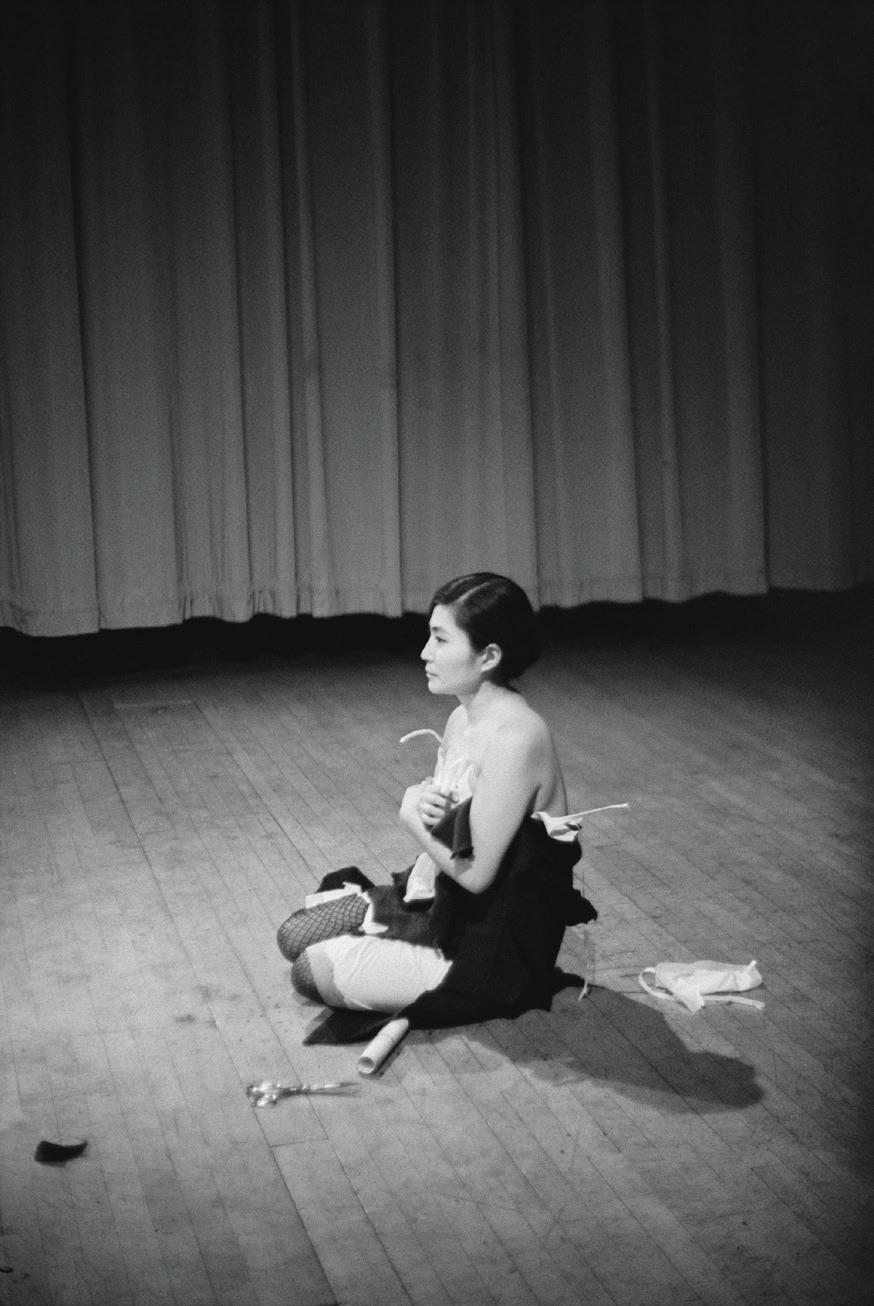

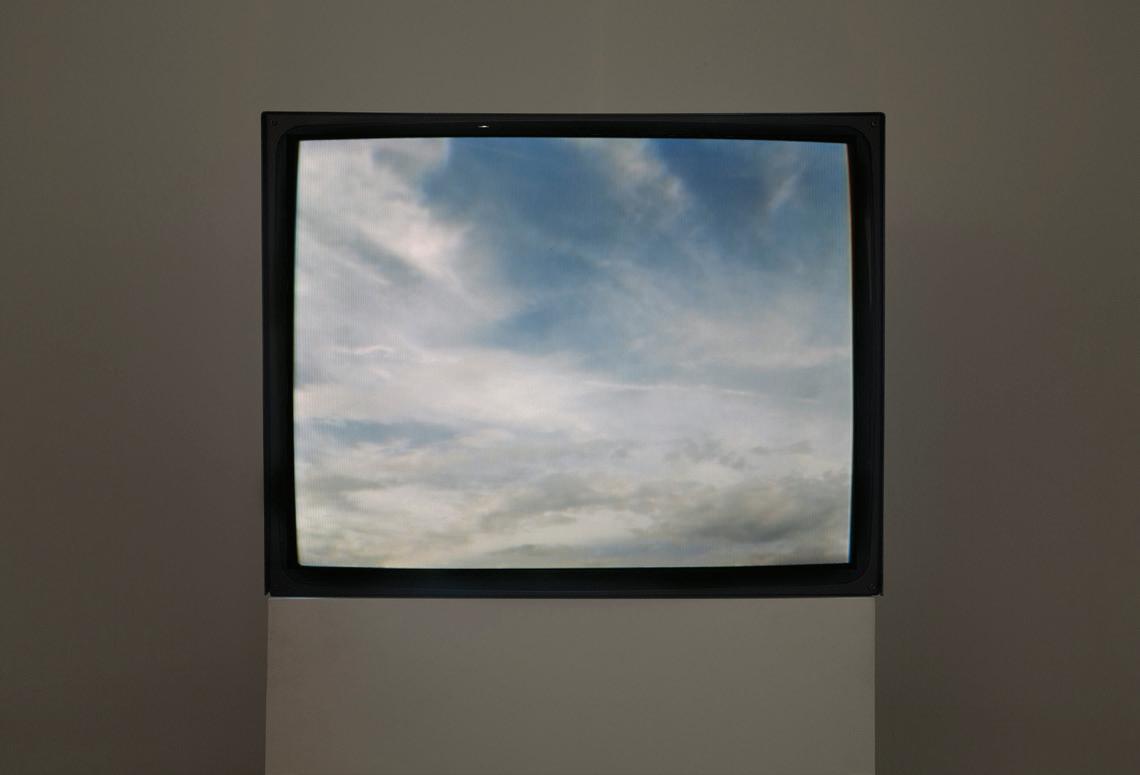
In “Music of the Mind,” Yoko Ono invites us to imagine.
By Kerry Cardoza, p. 10









In “Music of the Mind,” Yoko Ono invites us to imagine.
By Kerry Cardoza, p. 10

05 Feature | Prout Many unhoused residents go uncounted among the people disappeared by federal immigration agents.
06 Know Your Rights/ Conozca sus derechos What to know if you’re unhoused and approached by ICE
08 Feature | Marshall-Brown Border Patrol agents target rideshare drivers at O’Hare.
09 Make it Make Sense | Mulcahy State lawmakers pass a transit package, a new pilot offers free phone calls to people in Illinois prisons, and the mayor’s administration twice turned away city investigators.
10 Feature | Cardoza Yoko Ono’s unfaltering wish for peace
12 Feature The Museum of Broadcast Communications reopens.
14 Rhintestone Digest | Renken Taking your show on the road doesn’t have to be a drag.
15 Plays of Note The Baldwin|Giovanni Experience at Fleetwood-Jourdain celebrates two literary giants; The Pilon is a smart portrait of fan culture and friendship; The Wash highlights an unsung chapter of Black labor history, and more
16 Q&A jada-amina on her third year curating Black Harvest Film Festival
17 Moviegoer Watching movies leads to a man’s ashes
17 Movies of Note Violent Ends is a good movie for dads with limited imaginations; Nouvelle Vague fails to be remotely vogue.
18 Feature | Galil Hallogallo 2.0: What happens when a teen rock scene grows up?
23 Shows of Note Previews of concerts including Tortoise, M. Sage, Anycia, and the Great Lakes Dungeon Synth collective
26 Gossip Wolf | Galil The Chicago Asian American Jazz Festival celebrates its 30th anniversary, veteran producer the Twilite Tone and emerging rapper Your Stepdad drop new music, and more.
BACK
27 Savage Love Finding a final resting place for your old sex toys and more quick advice

Selected imagery from “Yoko Ono: Music of the Mind,” on view at the Museum of Contemporary Art through February 22, 2026. For more information, read the story on p. 10 or visit mcachicago.org/exhibitions/yoko-ono-music-of-the-mind. Clockwise from top le :
Installation view, “Yoko Ono: Music of the Mind,” MCA Chicago, October 18, 2025–February 22, 2026. Photo by Bob. (Robert Chase Heishman). Yoko Ono, FLY (still), 1970–71. 16 mm fi lm (color, mono sound). © Yoko Ono.
Yoko Ono, Apple, 1966. Installation view, Yoko Ono: One Woman Show, 1960–1971,
of
New York, NY, 2015. © Yoko
27
The Reader has updated the online version of “The Internet is ruining sex,’” written by Micco Caporale and originally published in our October 23 issue (volume 54, number 4). The original version of this story misattributed a quote by Kate Wagner to Carta Monir.
The Reader has updated the online version of “‘It’s important to write for teenagers,’” written by Micco Caporale and originally published in our October 30 issue (volume 54, number 5). The original version of this story mistakenly said Hal Schrieve and Jolene Saint met in 2021.
Find us on socials: facebook.com/chicagoreader twitter.com/Chicago_Reader instagram.com/chicago_reader linkedin.com search chicago-reader
The Chicago Reader accepts comments and letters to the editor of less than 400 words for publication consideration.
m letters@chicagoreader.com
INTERIM PUBLISHER ROB CROCKER
DIRECTOR OF ADVERTISING AND REVENUE
PRODUCTS AMBER NETTLES
CHIEF OF STAFF ELLEN KAULIG
ASSISTANT MANAGING EDITOR
SAVANNAH RAY HUGUELEY
PRODUCTION MANAGER AND STAFF
PHOTOGRAPHER KIRK WILLIAMSON
SENIOR GRAPHIC DESIGNER AMBER HUFF
GRAPHIC DESIGNER AND PHOTO RESEARCHER SHIRA
FRIEDMAN-PARKS
THEATER AND DANCE EDITOR KERRY REID
MUSIC EDITOR PHILIP MONTORO
CULTURE EDITOR: FILM, MEDIA, FOOD AND DRINK TARYN MCFADDEN
CULTURE EDITOR: ART, ARCHITECTURE, BOOKS KERRY CARDOZA
NEWS EDITOR SHAWN MULCAHY
PROJECTS EDITOR JAMIE LUDWIG DIGITAL EDITOR TYRA NICOLE TRICHE
WRITERS LEOR GALIL, MIKE SULA
WRITER KATIE PROUT SOCIAL JUSTICE REPORTER DEVYN-MARSHALL BROWN (DMB)
STAFF WRITER MICCO CAPORALE
SOCIAL MEDIA ENGAGEMENT
ASSOCIATE CHARLI RENKEN
VICE PRESIDENT OF PEOPLE AND CULTURE ALIA GRAHAM
DEVELOPMENT MANAGER JOEY MANDEVILLE DATA ASSOCIATE TATIANA PEREZ
MARKETING MANAGER MAJA STACHNIK
MARKETING ASSOCIATE MICHAEL THOMPSON
SALES REPRESENTATIVE WILL ROGERS
SALES REPRESENTATIVE KELLY BRAUN
SALES REPRESENTATIVE VANESSA FLEMING
ADVERTISING
ADS@CHICAGOREADER.COM, 312-392-2970 CREATE A CLASSIFIED AD LISTING AT CLASSIFIEDS.CHICAGOREADER.COM
DISTRIBUTION CONCERNS
DISTRIBUTIONISSUES@CHICAGOREADER.COM
READER INSTITUTE FOR COMMUNITY JOURNALISM, INC.
CHAIRPERSON EILEEN RHODES
TREASURER TIMO MARTINEZ
SECRETARY TORRENCE GARDNER
DIRECTORS MONIQUE BRINKMAN-HILL, JULIETTE BUFORD, DANIEL DEVER, MATT DOUBLEDAY, JAKE MIKVA, ROBERT REITER, MARILYNN RUBIO, CHRISTINA CRAWFORD STEED
READER (ISSN 1096-6919) IS PUBLISHED WEEKLY BY THE
READER INSTITUTE FOR COMMUNITY JOURNALISM 2930 S. MICHIGAN, SUITE 102 CHICAGO, IL 60616, 312-3922934, CHICAGOREADER.COM
COPYRIGHT © 2025 CHICAGO READER ALL RIGHTS RESERVED. CHICAGO READER, READER, AND REVERSED R: REGISTERED TRADEMARKS ® TO CONTACT ANY READER EMPLOYEE, EMAIL: (FIRST INITIAL)(LAST NAME) @CHICAGOREADER.COM
1 in every 20 print readers becomes a member.

Abductions by federal agents follow recent evictions from city parks.
By KATIE PROUT
The Latino Union of Chicago, via its Adopt a Corner initiative, organizes patrols to watch for Immigration and Customs Enforcement (ICE) and other federal agents at intersections and landmarks where day laborers gather to look for work.
One such spot is near the intersection of Lawrence and Pulaski, close to Gompers Park. Among the laborers gathered there the morning of October 29 was Theo, an unhoused man who lived in the area. His birthday was a day earlier. “Theo came to this housing site [near Lawrence and Pulaski] because he saw camaraderie with the other folks who are trying their best to survive,” said Adam, an Adopt a Corner participant.
Adam was friendly with Theo (both names are pseudonyms). The two talked often over baked goods donated by a nearby restaurant.
On October 29, Adam was patrolling a few blocks away when, at approximately 10:30 AM, a black SUV pulled into an alley southeast of Pulaski and Lawrence. In footage viewed by the Reader, agents with U.S. Border Patrol patches jumped out of the SUV and grabbed Theo, shoving him to his knees in the street before dragging him to the vehicle and pushing him inside. The abduction took less than a minute.
“They did not appear to identify him in any way beforehand,” wrote L.M. over Signal, who, like Adam, was volunteering with Adopt a Corner and witnessed the abduction. “There were about seven other day laborers on the corner there that scattered, and [the agents] seemed to just grab the first person they could get their hands on.”
At the same time Theo was being abducted, federal agents were kidnapping a second unhoused community member, Samuel, near Taqueria Morelia on Lawrence Avenue. Theo and Samuel knew each other, said Adam, and lived in the same unhoused community. The pair are two of at least 26 unhoused Chicagoans kidnapped by federal agents since the so-called
“Operation Midway Blitz” began in September. Two hours after Theo and Samuel were taken, Kiersten Solis stopped her vehicle near the tennis courts in Eugene Park, a couple blocks east of Gompers, and made a phone call to the Illinois Coalition for Immigrant and Refugee Rights. Solis has been an Albany Park resident for a quarter century. After hearing reports about that morning’s abductions in her neighborhood, she, like many Chicagoans across the city, responded by heading out into her community, towards possible danger, to warn neighbors of the federal threat. Ahead of her, a white SUV she’d noticed earlier pulled up to two black SUVs, one of which appeared to have just finished detaining a person who lived in an encampment in the park. “I caught the tail end of it,” she said, “as they were closing their doors and getting in.”
Lawrence–Pulaski intersection, is one of the city’s most diverse neighborhoods. In recent days, it’s been targeted especially hard by federal agents. “They’re like, ‘Oh, there goes another person of color,’” she said. “Let me grab them.”
As federal agents deployed to Chicago terrorize, brutalize, and arrest citizens, noncitizens, press, and anyone else they feel like, unhoused people are particularly vulnerable to their violence: heavily criminalized, culturally scapegoated, and with fewer smartphones and eyes to notice or bear witness to their abductions.
These factors make the abductions of unhoused Chicagoans di cult to verify and track. Their disappearances further highlight their vulnerability in a city that has seen multiple
“It is our collective responsibility to look out for our neighbors.”
While other neighbors blew their whistles, the black SUV, driven by agents Solis suspected had just abducted a park resident, took o . Meanwhile, two agents exited the white SUV she’d been watching. One, wearing tactical gear, a mask, and sunglasses, walked up to her car window and identified himself as a U.S. Border Patrol agent. “Can you please stop following us?” he asked while Solis filmed. “This is your final warning.” Solis pointed out this was her first warning and asked what she’d done wrong. Footage shows the agent walking away. Solis said they took down her license plate number, and later that evening, the same SUV, driven by the same agent, drove slowly past her home.
During an interview, Solis echoed what L.M., who witnessed Theo’s abduction, said. Albany Park, where Gompers and Eugene Parks are situated, and which contains the
high-profile closures of tent encampments, some in below-freezing temperatures. For example, Gompers Park, near where Samuel and Theo were taken, has featured prominently in headlines this year. It’s become a flash point for intense community disagreement about whether unhoused residents living in tents in the park should be evicted or allowed to stay at a time when Chicago is enduring an a ordable housing crisis. (There is no emergency shelter for unhoused single people on the city’s northwest side, where Gompers Park is located.)
The number of unhoused people living in Chicago increased significantly in 2023 and 2024, after Texas governor Greg Abbott bused approximately 51,000 migrants to the city. The majority of people in Chicago who are considered homeless by the federal government were longtime Chicagoans, according to an annual federal report, but on January 23, 2025,
the night the report survey was conducted, 17 percent were new arrivals.
Federal agents have appeared at shelters in the city originally designated for newly arrived migrants, but they also have appeared at long-standing Chicago shelters. Two people were taken from outside a shelter in Budlong Woods on September 25 and were later released. Four people snatched from outside a shelter in Bronzeville remain in custody, their status unknown. On October 9, ICE parked across the street from North Side Housing and Supportive Services, a men’s-only shelter in Rogers Park that has operated in the community for years, though they never approached the building. And on October 24, two people were abducted from outside a family shelter in North Park. Their status is also currently unknown.
The Reader asked the city’s chief homelessness o cer, Sendy Soto, and Mayor Brandon Johnson’s press o ce if they, or anyone else with the city, knew how many unhoused people have been taken from shelters and encampments and whether the presence of ICE impacted any future plans for encampment closures. Neither responded to our inquiries as of press time.
Some advocates argue that abductions by federal agents are not separate from the city’s approach to encampment sweeps but rather a continuation of it. (In an encampment sweep, the city uses heavy machinery to destroy and discard tents, along with any unclaimed belongings inside of them, while forbidding their unhoused owners from returning to live in a park under threat of arrest.) “Being unhoused isn’t a singular condition. It doesn’t exclude you from being a worker, paying taxes, or having the status of being targeted by ICE,” said Adam. In addition to his work with Adopt a Corner, Adam is part of Parks for All, a coalition of housed and unhoused Chicagoans who advocate for equitable use of city parks. He referenced three arrests of unhoused people that took place in 2025 during an off-street cleaning,

1. Over the weekend of September 27–28, 11 unhoused people were detained in Logan Square, according to a tip received by CCH.
2. Two independent eyewitnesses told street outreach workers that at least four unhoused people were arrested by federal agents around Belmont and Kimball early in the week of September 29
3. The Chicago Coalition to End Homelessness (CCH) was notified of a raid targeting unhoused people who were “congregating in a public space” near Milwaukee and Belmont on Thursday, October 2
4. There was also a possible detainment of four individuals at an encampment in Cicero
5. Two individuals were taken from outside a shelter in Budlong Woods on September 25 but were later released; the four snatched from outside a shelter in Bronzeville on October 1 remain in custody, their status unknown.
6. On October 9, ICE parked across the street from Northside Housing and Supportive Services (NHSS), a mens-only shelter in Rogers Park. The executive director of NHSS told Leslie Perkins, chief of staff for Alderperson Maria Hadden, that the agents never approached the building or tried to enter.
7. Also on October 9, CCH received a tip that ICE had shown up at an encampment in Warren Park in Rogers Park. Perkins asked the executive director of NHSS if he knew of any ICE enforcement in nearby encampments. “[His] staff had spoken about hearing that ICE was targeting encampments around the city, but didn’t have any knowledge of any specific detainments,” Perkins wrote over email.
8. Two people were abducted from a shelter at 3034 W. Foster in North Park on Friday, October 24
9. Two people from the new arrivals shelter near Foster and Kedzie
10. Two unhoused day laborers near Gompers Park (Pulaski and Lawrence) on Wednesday, October 29
Make time to learn something new with music and dance classes at Old Town School! We offer flexible schedules for all skill levels both in-person and online.
W hile there is uncertainty about the deployment of the National Guard in Chicago at the moment, there already is ICE enforcement targeted at the unhoused community.
1 . When interacting with federal agents or police, stay calm and remember you have the right to remain silent . Say “I am exercising my right to remain silent” and “I do not consent to a search of my body or my property.”
2 . Ask federal agents or police if you are free to leave. If told yes, leave. If no, try to remember everything you can about the arresting officer (uniform, badge number, and name), any witnesses, and say, “I want to speak to a lawyer.”
3 . Keep your photo ID with you at all times and consider asking a family member, friend, or case manager to store any important documents, such as your Social Security card, birth certificate, and property with sentimental value.
4 . Carry the phone number of an emergency contact with you, and if you have a phone, keep it charged and with you.
5 . It may be safer to sleep indoors, so explore whether you can stay with a supportive person on a temporary basis. If you need access to a shelter , please call 3-1-1 and write down your service request number (SR#). Tell 3-1-1 your location and that you are unsheltered and requesting shelter. Shelter capacity may be limited.
A You have the right to remain silent.
A You have the right to record federal agents anywhere, including the CTA. Always maintain an “arm’s length plus a step back” of distance.
A Please note that CTA violations (for example, smoking on CTA property) may have a heightened risk of enforcement.
A If officers arrest you because they think you committed a crime, you have a right to a government-appointed attorney. If officers have detained you because of your suspected immigration status, you have a right to a lawyer, but the government will not provide you with one.
To report ICE activity targeted toward the unhoused community or to get support for a family member or friend who has been detained, call the ICIRR Family Support Line at 855-435-7693 .
M ientras hay incertidumbre sobre el despliegue de la Guardia Nacional en Chicago, la migra ya está dirigida a las personas que experimentan la falta de vivienda.
1 . Durante interacciones con la policía o los agentes federales, mantenga la calma y recuerde que tiene el derecho a permanecer en silencio . Diga “ejerzo mi derecho a permanecer en silencio” o “I am exercising my right to remain silent” y “no consiento que registren mi cuerpo o mis bienes” o “I do not consent to searches of my person or belongings.”
2 . Pregunte a los agentes o la policía, “¿Estoy libre para irme?” o “Am I free to go?” Si te dicen que sí, vete. Si le dicen que no, intente recordar todo lo que pueda sobre el agente que le detuvo (uniforme, número de placa, nombre) y sobre cualquier testigo. Diga inmediatamente “quiero hablar con un abogado” o “I want to speak to a lawyer.”
3 . Carge siempre con usted un documento de identidad con fotografía y considere pedir a un familiar, amigo o gestor de casos que guarde en un lugar seguro cualquier documento importante (como la tarjeta del Seguro Social o el certificado de nacimiento) y/o bienes con valor sentimental.
4 . Lleve con usted el número de teléfono de un contacto de emergencia , de un familiar, un amigo o un gestor de casos. Mantén tu teléfono totalmente cargado siempre que sea posible, si tienes uno.
5 . Puede ser más seguro dormir en el interior, así que explora si puede quedarse con una persona de apoyo de forma temporal. Si necesita acceder a un refugio , llame al 3-1-1 y anote el número de solicitud de servicios o “service request number” (SR#). Indique al 3-1-1 su ubicación y diga que no tienes hogar y que estás solicitando refugio. Tenga en cuenta que la capacidad del refugio puede ser limitada.
A Tiene derecho a permanecer en silencio.
A Tiene derecho a grabar a los agentes federales, incluyendo el CTA, pero mantenga siempre una distancia de “un brazo más un paso atrás.”
A Tenga en cuenta que las infracciones de la CTA (como fumar o vapear en el tren) pueden conllevar un mayor riesgo de aplicación.
A Si los oficiales lo arrestan por sospecha de haber cometido un delito, tiene derecho a un abogado designado por el gobierno. Si lo detienen por su estatus migratorio, también tiene derecho a un abogado, pero el gobierno no le proporcionará uno.
Para informar sobre la actividad de la migra dirigida a las personas que experimentan la falta de vivienda o para obtener apoyo para un familiar o amigo que ha sido detenido, llame a la línea de apoyo familiar de ICIRR al 855-435-7693 .
a sweep of an encampment, or shortly thereafter. “Racking up charges, throwing them in jail, especially of folks of mixed status,” raises the profile of unhoused people and draws attention from ICE, he continued.
In August, National Guard troops in Washington, D.C., also called in by President Donald Trump, descended on encampments throughout the capital. By September, the federal government boasted it’d destroyed at least 50 encampments. At an August media briefing in response to the D.C. deployment, Soto said local Chicago officials will not help federal agents clear camps. “The city believes firmly that being unhoused is not a crime, so we will not be assisting with any sort of arrest or enforcement toward the unhoused community for being unhoused,” she stated.
But the City of Chicago doesn’t need federal help. Under Soto’s tenure, the Johnson administration, with the help of armed local police officers, has razed multiple encampments, including in Humboldt Park, Gompers Park, the embankment near Des Plaines and Roosevelt, and Legion Park, displacing at least 160 people. Many were o ered temporary stays in shelters and help navigating the city’s housing system, but many others either weren’t contacted by outreach workers or declined the shelters for many reasons. Instead, they moved into motels, moved onto the couches and floors of others, moved to another city park, or disappeared. Important personal papers—birth certificates, state IDs, Social Security cards, and passports—are frequently lost or destroyed in the process, as are relationships and homes.
Like housed immigrants in the city, who have been forced to miss work and forgo trips to the grocery store, unhoused Chicagoans have lost access to life-sustaining resources because of the danger posed by ICE and other federal agents. However, community members like Adam and L.M., mutual aid groups like the Latino Union, block clubs, and neighbors are organizing to look out for others, both housed and unhoused, who are especially vulnerable to ICE’s violence. And service providers in the city are working to get unhoused Chicagoans the information they need to protect themselves as best they can. “Chicago advocates were hearing concerns from unsheltered community members about how to navigate potential federal enforcement presence and interactions in public spaces, especially public transportation,” wrote Melissa West, sta attorney and Equal Justice Works fellow with the Law Project of
the Chicago Coalition to End Homelessness, over email. In response, the Chicago Coalition to End Homelessness worked with local mutual aid organizers, as well as advocates in D.C. who endured troop deployment earlier this year, to create a know your rights one-pager for unhoused people. “Know Your Rights as an Unsheltered Person: Public Transportation, Checkpoints, at the Airport” is available in both English and Spanish. [Editor’s note: Find an abridged version on p. 6.]
One way to stop unhoused people from being targeted by federal agents is to stop them from becoming homeless in the first place. On October 18, the All-Chicago Tenant Alliance (ACTA) called on Johnson and Governor J.B. Pritzker to initiate an eviction moratorium until the federal occupation of Chicago ends. (The Reader asked Johnson’s o ce for comment, but did not receive a response.) “We understand that if I.C.E. wants to break into apartment buildings, they will try. They already have,” the alliance posted on Instagram. In September, an ICE raid on a profoundly neglected South Shore apartment building may have been the result of a tip from the building’s landlord, according to an unnamed o cial who spoke to the Associated Press. “It costs a lot more money to evict someone than it does to call ICE on them,” one building tenant told In These Times. In West Ridge on October 21, ICE broke into an apartment and abducted a man as his neighbors shouted. “Nevertheless,” the ACTA post continued, “when nowhere is safe, home is the best option. Apartment buildings can be organized and defended.”
The Belden Sawyer Tenant Union in Logan Square has joined in the moratorium eviction call, and Fuerzas Activas de la Damen (FAD), a tenant union representing four buildings and two hundred-plus families in Rogers Park, has also drawn a connection between a lack of safe, a ordable housing and ICE. After negotiations with their new landlord stalled, FAD announced a rent strike on October 20. In a press release, the union wrote that any evictions filed by their landlord would be “kicking out mostly Mexican tenants in the middle of an ICE crackdown in Chicago, putting them in incredible danger.”
On Saturday, yet another unhoused person living in the area was abducted from the Lawrence–Pulaski corridor. This person, like Samuel, knew Theo, according to area community members. Their absence is noticed; they are missed. “It is our collective responsibility,” said Adam, “to look out for our neighbors.” v
m kprout@chicagoreader.com


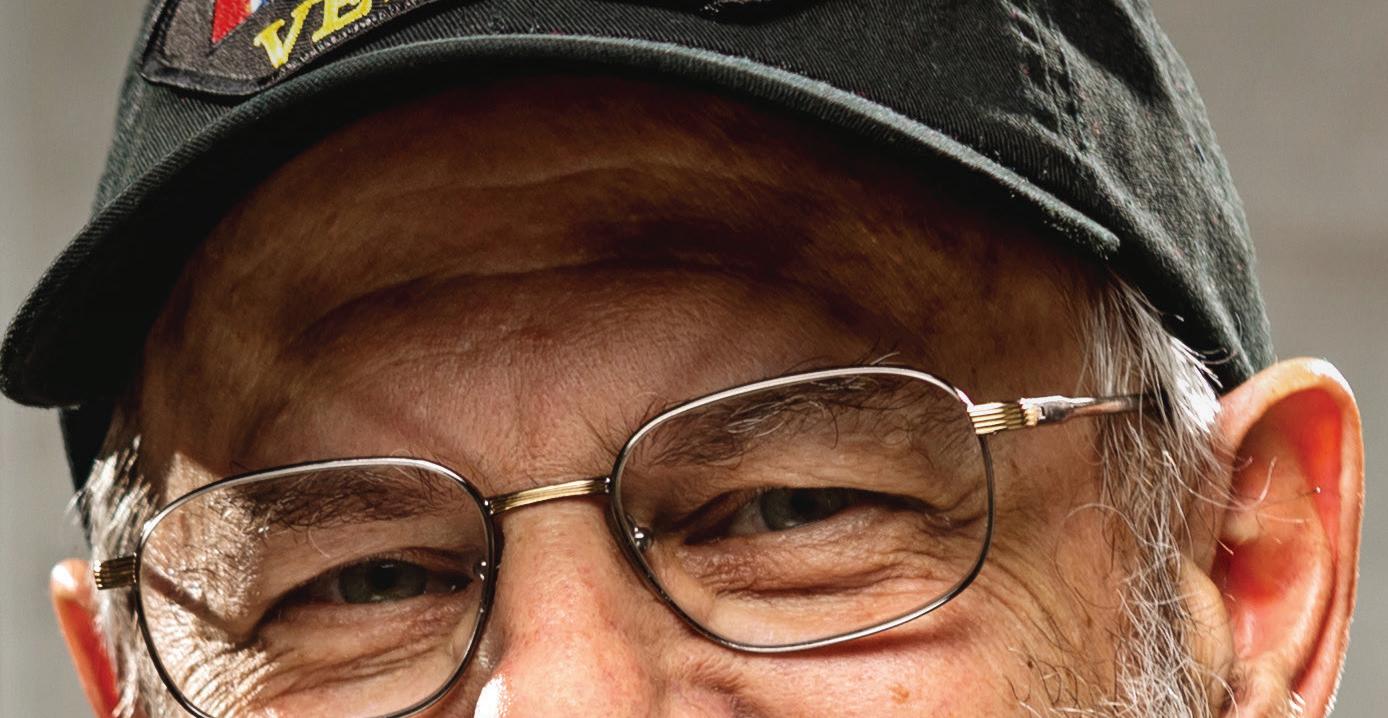













Federal agents have repeatedly terrorized rideshare drivers at O’Hare International Airport.
By DEVYN-MARSHALL BROWN (DMB)
The rideshare driver waiting areas at O’Hare International Airport have restrooms, food trucks, and spaces for religious worship. At any time, as many as 70 Uber and Lyft drivers can usually be found parked in one of two designated lots. But, in recent weeks, the waiting areas have been nearly empty, even at peak travel times, amid widespread fear of federal agents, who have repeatedly abducted drivers with legal work permits from their cars and disappeared them to immigration jails or fast-track deportation flights.
Between October 10 and November 2, federal agents targeted the rideshare parking lots on nine separate days, according to interviews and video reviewed by the Reader . In some cases, agents with U.S. Border Patrol or Immigration and Customs Enforcement (ICE) abducted drivers multiple times in a single day, taking as many as ten to 20 people each time. “I could be a citizen or be a resident, but me being Hispanic and cinnamon color, they could [still detain] me,” says Emmanuel Martinez, a rideshare driver of eight years who relies on trips to and from the airport. Martinez doesn’t know when he’ll feel safe going back to the lots. “It’s gonna be a while,” he says.
The Illinois Drivers Alliance partnered with the City of Chicago to hire 24/7 security and install signs making clear the lots cannot be used for civil immigration enforcement, but the raids have continued unabated. City-hired security guards sit in their cars while raids ensue, telling drivers they don’t have the authority to enforce the sign and physically stop federal agents, says Lori Simmons, lead organizer at the Chicago Gig Alliance, the rideshare worker organizing arm of the People’s Lobby.

“These are not targeted raids,” Simmons says. “[Federal agents] don’t know who these people are ahead of time. . . . I think they just have gotten wind that that’s where rideshare drivers are, and they probably have learned that they are a mostly immigrant population.”
The raids have largely been abrupt and aggressive. They’ve left drivers scared, confused, and in tears following the disappearances of friends with temporary protected status, asylum status, refugee status, or green cards. “The issue is that there is nowhere to escape once they begin, because there is only one point of entry and exit at these lots,” says Lenny Sanchez, director of the Illinois chapter of the Independent Drivers Guild. On multiple occasions, drivers exited their cars and ran, then jumped the chain-link fence bordering the lot to try to run toward Mannheim Road, where they were detained immediately by Border Patrol agents waiting on the hills in their trucks, positioned to catch anyone trying to escape.
On October 20, the first day city-hired security guards were stationed at the lots, federal agents started stopping rideshare drivers just outside the waiting area. Less than a week later, they’d returned to the lots, ignoring security as they moved from car to car.
Illinois Drivers Alliance organizers set up a watch calendar to monitor the O’Hare rideshare lots around the clock so they can alert drivers to raids and support them afterward.
When federal agents target the waiting areas, fellow drivers write down their peers’ license plate numbers and try to find out who might’ve been taken. Then, people like Sanchez and Simmons notify the broader community of drivers through forums like WhatsApp and Facebook. But it’s impossible to reach everyone.
Sanchez says many drivers double-park while waiting to pick up riders at the airport. In some instances, Sanchez says he saw Chicago police ticketing cars of people who’d been abducted. Soon after, airport officials towed the vehicles away. Other rideshare drivers’ cars sat abandoned in the parking lots for days. During one abduction, a man from Venezuela threw his car keys at a nearby driver and said he’d call his cousin when he could to collect them. Others used spare keys to recover stranded cars, but some cars left behind have since been towed.
Organizers tell the Reader it’s often di cult to figure out who agents took. Sanchez recalls searching two abandoned cars for any identifying information to no avail. In the center console of one of the cars, he found a Barbie doll and sandals likely belonging to a young girl.
Bailey Koch is an Illinois Drivers Alliance spokesperson and communications director for Service Employees International Union (SEIU) Local 1—one of the unions helping to organize rideshare drivers across the state.
“It’s pretty vague on who’s being detained,” she says, “where they are being taken, what is happening to their vehicle when they are taken, when they’re calling a tow truck to get it, and where their car is going.”
The choice to target drivers, who are required by rideshare apps to have legal work authorization in the U.S., is nothing more than racial profiling.
“Donald Trump needs the numbers,” Sanchez says. “It’s a low-hanging fruit. It’s like shooting fish in a barrel. . . . Seventy percent of the drivers for rideshare are immigrants or first-generation descendants of immigrants, so they know that they’re able to snatch up a lot of people that haven’t been here for two years and could be eligible for expedited deportation.” Uber requires users to provide a Social Security number before creating an account. Lyft allows drivers to create an account with a temporary identification number so long as they’ve had their license for at least a year.
The Illinois Drivers Alliance and the Illinois Coalition for Immigrant and Refugee Rights have been hosting virtual know your rights training sessions in English, Spanish, and Arabic for rideshare drivers and their families.
During the trainings, organizers help drivers create an emergency plan, set up a power of attorney, and encourage them to memorize important phone numbers in case they’re detained.
Alliance member groups are making sure they continuously have people on the ground to document the federal raids and to comfort drivers in the disarray.
All the while, drivers, regardless of their immigration status, are now doing their job in fear. “The raids that have been happening have caused complete chaos, not only for the rideshare drivers,” Koch says. “They don’t just take people to and from the airport. They handle essential needs that our families have, whether that’s bringing our kids to school, getting us to work—people utilize rideshare drivers to get to the emergency room because it’s more affordable than calling 911. So, they’re really essential to all of it.” v

State lawmakers capped off the 2025 legislative year with a predawn vote on a $1.5 billion proposal to fund Chicago-area public transportation.
Senate Bill 2111, given final approval by the Illinois General Assembly around 4 AM on October 31, seeks to divert state sales tax revenue on gas purchases and interest accrued by the state’s Road Fund to local transit agencies. It would also replace the Regional Transportation Authority (RTA)—which oversees the Chicago Transit Authority (CTA), Metra , and Pace —with an overhauled leadership structure under the newly created Northern Illinois Transit Authority
The RTA, CTA, Metra, and Pace together face a $230 million shortfall in 2026 thanks to expiring federal pandemic relief money. Local o cials and public transportation advocates warned for months that passengers could be slapped with drastic rate hikes and service cuts if lawmakers failed to help transit agencies bridge the gap. Lawmakers, on the other hand, including lead sponsor Senator Ram Villivalam, repeatedly cautioned that there would be “no funding without reform.” The various interested parties—policymakers, advocacy groups, the governor’s o ce, and labor unions—negotiated throughout the spring and down to the final moments of the fall veto session, which was slated to end on October 30. Separately, state lawmakers passed a bill that would prohibit federal agents from making civil immigration arrests in state courthouses and allow Illinoisans to sue o cers who violate their due process rights.
A wide-ranging energy reform package approved by both chambers would lift a longstanding moratorium on large-scale nuclear power and enact new government incentives for battery storage projects. And an amendment to the Clean Slate Act would automatically seal certain low-level criminal convictions. All are awaiting Governor J.B. Pritzker’s signature as of press time.
The Illinois Department of Corrections (IDOC) announced the agency is piloting a new program to provide every person incarcerated in the state with access to free phone calls each month.
The so-called “Voices of Connection” initiative rolled out on November 3 and grants Illinois prisoners 775 free minutes of domestic phone calls per month, worth about $6.20, according to a press release. A local phone call to a person in an Illinois prison costs about $0.01 per minute.
The change comes on the heels of an October 28 decision by the Federal Communications Commission, under pressure from companies and corrections officials, to increase the nationwide rate caps for phone and video calls by as much as 83 percent.
Phone calls are just one of the many services prison systems nationwide have outsourced at the expense of incarcerated people and their loved ones. Everything from health care to food is now handled by private companies.
Another service IDOC is hoping to soon make permanent is universal mail scanning. On November 4, the Joint Committee on
Administrative Rules held a hearing on proposed rules that seek to generally ban paper mail into state prisons. The rulemaking body previously objected to a similar emergency proposal, though the decision did not block the rule from taking e ect through January.
Chicago inspector general Deborah Witzburg is urging Mayor Brandon Johnson’s o ce to “take appropriate steps to ensure that City premises are made available” to investigators, according to an official advisory sent to the mayor’s o ce on September 24. It comes after the O ce of Inspector General (OIG) claims it was twice obstructed from inspecting government property.
A report published by the OIG on November 4 details two separate instances in which investigators were prevented from making unannounced inspections. The first, a surprise audit of the mayor’s “gift room,” was detailed in an earlier OIG publication and covered by multiple media outlets. The second “thwarted





unannounced inspection” occurred in July, according to the OIG. An attorney with the city’s Department of Law allegedly instructed a city employee not to allow investigators into an o ce “to search for items which OIG believed were being stored there in violation of City policy.” Investigators returned several weeks later, accompanied by the law department, and “confirmed the presence of those items in the o ce.”
Johnson’s chief of sta , Cristina PacioneZayas, argued in a response dated October 31 that “the actions of the Mayor’s O ce do not reflect obstruction.” In defense, Pacione-Zayas cited an unrelated provision of the OIG’s rules and pointed to “evolving interpretations of the City’s Governmental Ethics Ordinance.” Johnson’s o ce seemingly did not commit to enacting any of Witzburg’s recommendations.
—SHAWN MULCAHY v
Make It Make Sense is a weekly column about what’s happening and why it matters.
m smulcahy@chicagoreader.com





















For Yoko Ono, ideas visualized in our minds are the most important of all.
By KERRY CARDOZA
“PEACE is POWER” is plastered on the facade of the MCA. One of Yoko Ono’s prevailing sentiments, it’s a fitting beacon for her in-depth retrospective now on view at the museum. Part advertisement, part radical koan—the simple black-text-on-a-whitebackground presentation is pure Yoko.
Much of the artist’s work is like this; at first glance, it seems simple, perhaps trite. It’s the my-kid-could-make-this but for conceptual versus abstract art. But prod into the work just a touch deeper and the radicality—the prescience of Ono’s vision—begins to make itself obvious. Walking through the exhibition, “Yoko Ono: Music of the Mind,” which is organized loosely chronologically, you’ll encounter Ono again and again at the epicenter of the avant-garde or at the forefront of major transformations in the world of art. (With music, she’s been mostly ahead of her time.) She performed with John Cage and ran an experimental art space with La Monte Young in New York in the early 60s (where she rubbed elbows with the likes of Isamu Noguchi and Marcel Duchamp). She was in New York City for the birth of Fluxus, then in Japan for the explosion of postwar conceptual art. She self-published a groundbreaking artist book in 1964, around the same time she began playing with the idea of advertisement as artwork, illustrating her innate understanding of the power of publicity.
But beyond Ono’s art historical importance, “Music of the Mind” is an invitation to imagine. We’re in a moment where it feels dangerous to let down our guard, even for just a minute. Cynicism is the default; trust among Americans is on the decline. “PEACE is POWER” might make you scoff. But what if you didn’t? What if you make the choice to visit this show with a spirit of openness, with
Through 2/22/26 : Tue 10 AM–9 PM; Wed–Sun 10 AM– 5 PM, Museum of Contemporary Art Chicago, 220 E. Chicago, visit.mcachicago.org/exhibitions/yoko-ono-music-of-the-mind, suggested admission, Chicago residents $19, Chicago students, teachers, 65 + $10, non-Chicago residents $22 , non-Chicago students, teachers, 65 + $14

the desire to have a little fun? When you’re through, you might just feel a little mental clarity. You might feel a little lighter. You might feel like giving peace a chance.
Peace is not theoretical for Yoko Ono.
During U.S. bombing raids in Tokyo in 1945, then 12-year-old Ono was evacuated to the countryside. Her family’s upper-class status could not protect them from the war’s privation. She and her younger brother often went hungry. Lying awake at night, looking up at the sky through an opening in the roof, she’d ask him to imagine the sort of food he’d most like to eat. This early experience of conceiving something in one’s mind, something that seemed as real as any tangible thing, and which provided comfort, was a formative one for the artist. (As was the assurance felt at the constant presence of the sky.)
Prior to the war, Ono was enrolled at Jiyu Gakuen preschool, which provided musical training. Students learned perfect pitch and composition, and, for homework, had to transcribe the sounds of their environments.
In her early years, Ono moved between the U.S. and Japan for her father’s job, thus
establishing a toehold in both cultures. She was the first woman philosophy student at Gakushūin University. After two semesters, she transferred to Sarah Lawrence (her family was then living nearby), where she studied poetry and musical composition. It was at Sarah Lawrence that she wrote what would become the earliest of her “instruction” pieces, such as Secret Piece, from the summer of 1953. It reads: “Decide on one note that you want to play. Play it with the following accompaniment: The woods from 5 a.m. to 8 a.m. in summer.”
To her parents’ dismay, Ono eloped with composer Toshi Ichiyanagi, dropping out of Sarah Lawrence and moving to New York City. With that move, Ono’s path was decided. She would not follow her parents’ bourgeois footsteps (her father worked at the Bank of Tokyo, her mother’s family founded one of Japan’s largest banks); she would be an artist.
In New York, Ono began making her instruction paintings, conceptual works whose titles described how the pieces were to be executed. One of the most well-known, Painting to Be Stepped On, consists of a scrap of canvas on the floor. It’s one of the first pieces installed
in the MCA galleries. Be sure to look down, or you might miss it.
In 1961, she had her first solo exhibition, at AG Gallery—run by George Maciunas, who was the mastermind behind the Fluxus art movement of which Ono is often associated. She also began working in performance at this time, immersing herself in the avant-garde scene through a performance series at her Chambers Street loft. This era is beautifully depicted at the MCA in black-and-white photos by Minoru Niizuma. Among the dark-clad audience, you might spy Robert Rauschenberg, or Noguchi, or Ono herself, hair down and holding a beer.
In 1962, she followed her husband to Japan, where she stayed for the next two years. It was here that her practice took several decisive steps. At a 1962 concert at Tokyo’s Sogetsu Art Center, Ono presented her instruction pieces as written statements for the first time—without any other physical counterpart. The works, displayed outside the concert hall, were neatly handwritten in Japanese by Ichiyanagi. Ono wanted to make sure the pieces were divorced from her own hand so that audiences would not equate

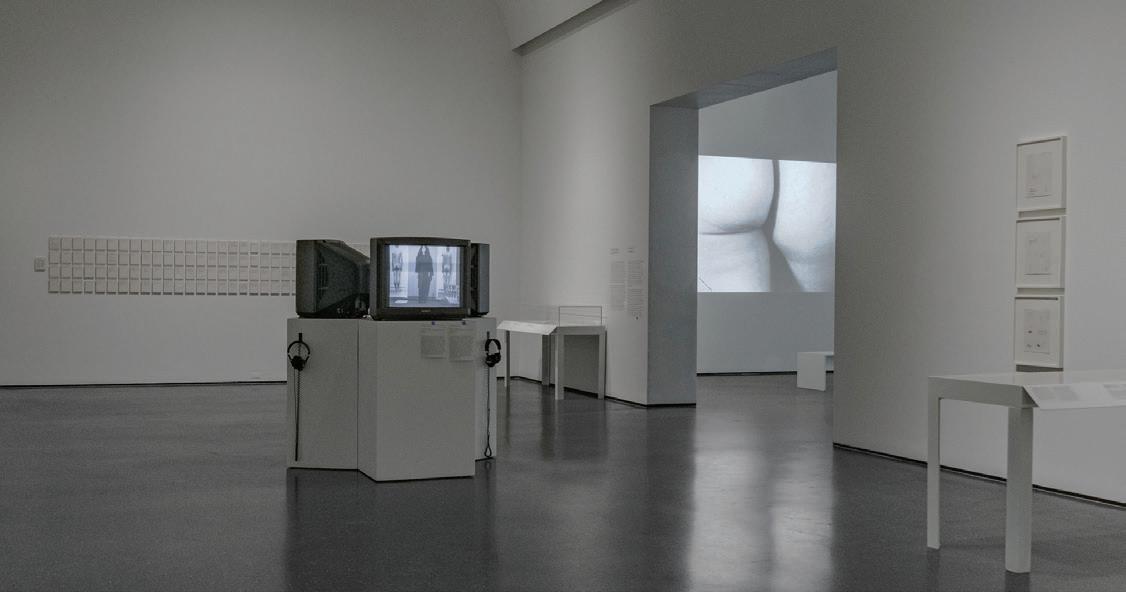
their execution, their physical presence, with the work itself. These artworks are meant to be realized either in real life or in the audience’s mind.
Instructionalizing her works allowed Ono a new kind of freedom. “I discovered that by instructionalizing art you did not have to stick to the two-dimensional or threedimensional world,” Ono told interviewer Hans Ulrich Obrist in 2001. She could now create works faster than ever, no longer bound by any financial or technical constraints. It was also an exercise in letting go of ego. “In those days, artists and musicians were slow in allowing others to touch their work,” she told Obrist. But Ono’s experience of life and of art was not one of stasis. She’d seen statues or works of art destroyed by war or time. “So, as an artist, instead of trying to hold on to what was impossible to hold on to, I wanted to make ‘change’ into a positive move.”
While in Japan, Ono also debuted what is perhaps her best-known work, Cut Piece Seated on the floor in a performance space, wearing her best clothes, Ono invites the audience to come on stage one by one and cut o a piece of her clothing. The work has been
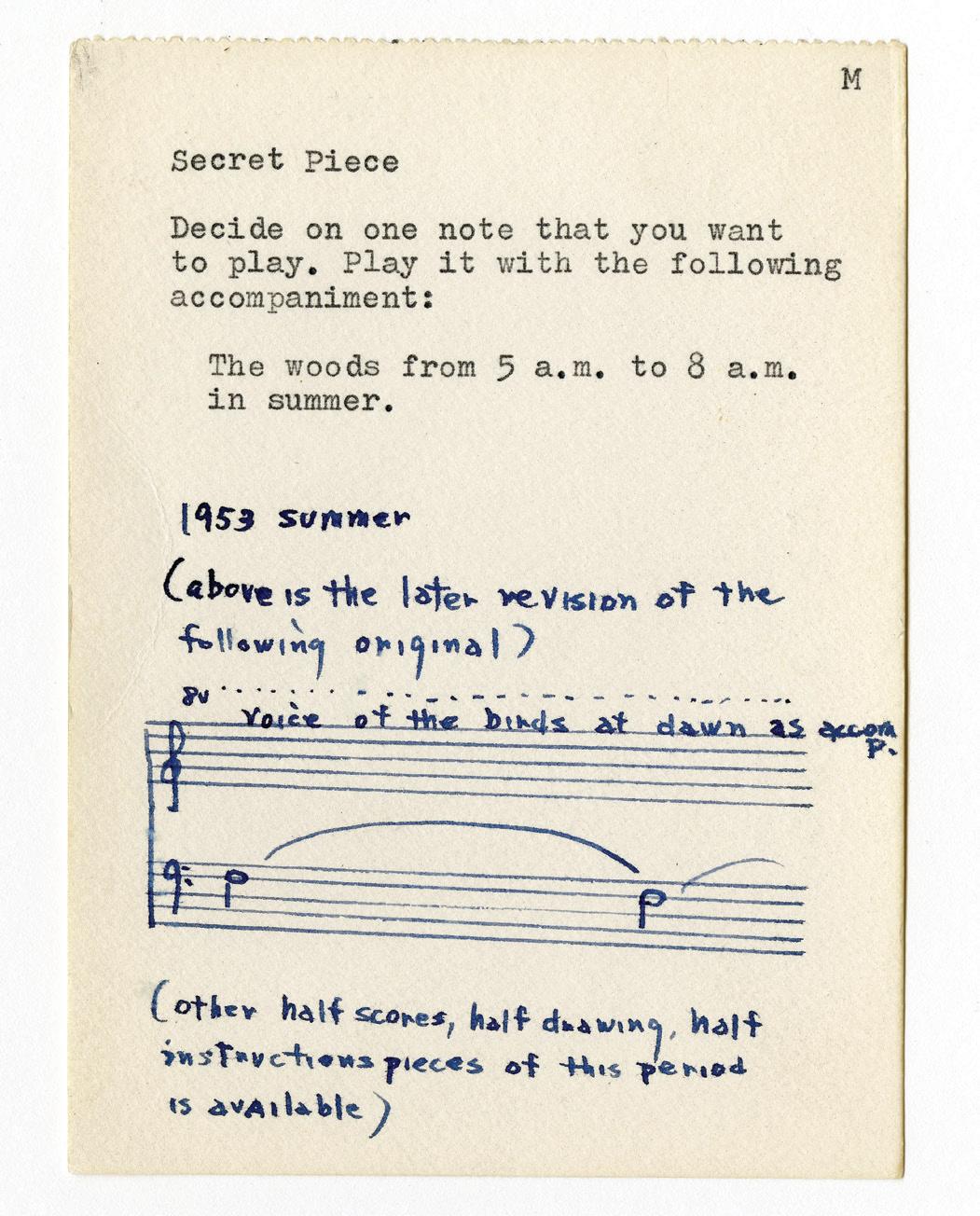
hailed as a pioneering example of feminist performance art, as a commentary on the Second World War, as an exercise in trust. Part of its brilliance, of course, is this ability to mean so many things to so many people. (A later iteration of the performance, filmed by documentarians Albert and David Maysles, plays in the gallery.)
Watching the Maysles’s footage is deeply uncomfortable. The audience is mostly quiet, with the odd cough or bout of nervous laughter breaking through the silence. Ono sits mostly expressionless, in a demure top and skirt, a large pair of fabric shears at her side. But a close-up of her face shows a sprinkle of perspiration on her nose. Near the eight-anda-half-minute video’s end, some smug weasel returns to the stage, cutting off the entire top half of her slip and snipping both her bra straps. “Stop being such a creep!” one woman calls out.
Ono remained in New York for the next two years—now married to American Anthony Cox, with whom she had a daughter, Kyoko—before heading to London to take part in the Destruction in Art Symposium. Ono was one of two women who took part in
the programming, though her participation was not without controversy, with some of the participants asking for her removal because her artwork didn’t su ciently engage in destruction. Her talk at the symposium appropriately excoriated the idea, explaining that physical artworks may be destroyed, but the image of them will remain in one’s mind.
As Ono told artist Gustav Metzger in 2009, “I was very impatient with men, especially male artists. They were all so dumb, I thought. So I was certainly not afraid of saying what I wanted to say.” In an introductory video at the MCA, Ono’s studio director, Connor Monahan, paraphrases the artist’s stance: “The job of the artist is not to destroy but to change the value of things.”
Ono ended up staying in London. Her relationship with Cox was ending but her career was on the ascent. Her landmark 1966 exhibition, “Unfinished Paintings and Objects by Yoko Ono,” at Indica Gallery, included new conceptual works and ideas that she has returned to again and again, such as an all-white chess set that visitors can play, iterations of which are available at the MCA.
The artist frequently revisits concepts or re-
stages participatory pieces. Take for example her interest in the English word “fly,” which denotes both the winged insect and the ability to take flight. An early performance piece invited audience members to climb a ladder and then “fly” o . Ono and John Lennon later collaborated on a film wherein a fly lands on a woman’s nude body, for which they composed a soundtrack; Fly is also the name of a 1971 record by the artist.
In London, Ono made headlines with Film No. 4 , which features a montage of people’s naked bottoms; a feature-length version was banned by the British Board of Film Censors. Ever true to her desire for peace, Ono conceived of the film as an anti-war statement, likening it to another idea she had to film every smile in the world. “This way, if [President] Johnson wants to see what sort of people he killed in Vietnam that day, he only has to turn the channel,” she wrote at the time. It was at her Indica Gallery show where Ono first met Lennon; the two immediately clicked. By 1969, they were married and well into their extended collaborations in music, art, and peace activism. Their first public appearance together was 1968’s Acorn Event, wherein they planted two acorns while facing east and west, respectively, at Coventry Cathedral, which the exhibition notes was a “symbolic site of reconciliation for the violence of the Second World War.” The couple followed this up, in 1969, with a mass mailing of acorns to 96 world leaders, which they were asked to plant in the name of peace. The MCA features written responses from the o ces of the Republic of South Africa president Jim Fouché and Israeli prime minister Golda Meir, whose assistant director wrote that Mrs. Meir would indeed like to see the “underlying symbolism . . . take root
“I was very impatient with men, especially male artists. They were all so dumb, I thought.”
within a realistic framework.”
The MCA does a respectable job of including Lennon as an important artistic and life partner for Ono without letting his celebrity overshadow her. But Lennon died in 1980 and Ono has been making music and art for the following four-plus decades, you might think, so surely people don’t still harbor those misogynistic thoughts? I thought so too, until I read
continued from p. 11
a 2022 New Yorker article by Louis Menand, who writes, “There is no question that museums and galleries mount these shows and people go to see them because Ono was once married to a Beatle.” I am happy to report that on the Sunday morning I visited the show, the galleries were filled with people of all ages, including Zoomers for whom I can only imagine the Beatles don’t play a particularly important role—all of whom were diligently studying the works on display, not just the ones that included Lennon.
The latter half of the exhibition is filled with videos and documentation of works such as Ono and Lennon’s honeymoon “bed-in” events, where they invited the press into their hotel suite to advocate for world peace; their “War Is Over” billboard campaign; and Ono’s Museum of Modern (F)art piece, wherein the artist advertised her one-woman show at MoMA that did not technically exist, except in the audience’s mind of course.
It’s impossible to visit this exhibition and not be struck by the contemporary artists who are taking up Ono’s mantle: From David Horvitz, whose children’s book Touch the Sky With Your Eye contains such Ono-like instructions as “Hide all the clocks to forget the time,” to Chicago’s own Jesse Malmed, who posted a 2011 Craigslist ad looking for someone to sublet his art practice, and from the feminist performance project of Pussy Riot, which encourages anyone to join, to Beyoncé, whose Mrs. Carter tour featured a giant screen bearing the word “Feminist,” in a similar typeface as the word “Freedom” appears in Ono’s 1970 video of her trying to free herself from her bra.
The exhibition originated at the Tate Modern in 2024; the MCA is so far its only scheduled U.S. presentation. We are extremely fortunate to have this monumental show on view in Chicago. My advice is to go see it now, and then again and again. And bring a friend, in order to fully participate in the pieces on view: trying on a large black bag, tracing a shadow on the wall, playing chess, mending broken pieces of ceramic, imagining peace. The continuing importance of that last one is most evident in Add Colour (Refugee Boat), one of the final pieces on view, which was inspired in part by images of refugees arriving to Europe by sea in 2016. Visitors are invited to contribute their hopes on the gallery floor and walls in blue marker. Most prominent were pleas to “Free Palestine.” v
m kcardoza@chicagoreader.com
R“JOHNNY CARSON: THE CENTENNIAL”
Through 1/1/27: Sun noon–6 PM, Wed, Fri–Sat 10 AM–6 PM, Thu noon–8 PM, Museum of Broadcast Communications, 440 W. Randolph, museum.tv/exhibits, adults $19, seniors, military, and veterans $17, students $16, children 6 and under free
A
new exhibition pays homage to the endurance of late-night
By BIANCA BOVA
The Museum of Broadcast Communications (MBC) opened its doors in 1987 and remained so until circumstances related to real estate caused operations to be suspended in 2023. This year, under the leadership of its newly appointed interim president and CEO, David Plier, the MBC has reestablished itself at 440 W. Randolph, where its grand reopening was feted with a redcarpet gala hosted by NBC 5 Chicago news anchor Allison Rosati.
Television and radio are not media that lend themselves comfortably to conventional exhibition formats. The MBC ultimately does a fine (if riskless) job of executing its shows, relying on wall-wrap didactics, monitor-based video and audio installations, and related ephemera.
Its permanent collection galleries encompass the Radio Hall of Fame, a small but delightful exhibition devoted to the infamous Disco Demolition Night at Comiskey Park, and a comprehensive retrospective of WLUP “the Loop” 97.9 FM, among others.
In one gallery focused on children’s shows, the objects on view come across as something akin to taxidermy. The faceless mannequin dressed in Bozo the Clown’s costume, wig, and nose, and the veritable storehouse of puppets from a host of midcentury programs turn uncanny in their inertia. Rather than being o -putting, this is an added thrill. Seeing the genuine article, one is left with the sense of having peered behind the curtain. It is this approach to installations by the MBC that best captures the dynamic quality of production-based media.
The museum’s headline exhibition, “Johnny Carson: The Centennial,” is thorough, encompassing everything from an interactive scale model of the famous desk and chairs to showworn suits and original artwork that graced the program’s bumpers. It strikes a thoughtful balance, satisfying in its depth to those of the generation for whom Carson is the embodiment of television entertainment, while still serving as a cogent entry point for those who
are young enough to have never heard of him at all.
“The Evolution of Late Night Television” is somewhat slipperier. The objects on view are less archival and more set dressing—in some instances, literally. A wall panel from the Ed Sullivan Theater doesn’t tell us anything about Ed Sullivan, or about David Letterman, from
nightly newscast he follows. With a comforting formulaicness, he will deliver some combination of lighthearted commentary, softball interviews, and music. Within those confines, all manner of convention-breaking has taken place. Jack Paar quit live on the air midprogram; Steve Allen submerged himself in a vat of Jell-O; Letterman produced a program in which the image of the broadcast appeared in stereo, rotating a full 360 degrees over the course of an hour; Seth Meyers took to reading viewers’ corrections of his previous night’s programs and enacting changes in accordance.
“Evolution” fails to acknowledge the richness and strangeness of its subject, choosing to serve instead as a primer—albeit one that nods to oft-overlooked but culturally significant programs like Friday Night Videos , The Tomorrow Show, and Chicago’s beloved Svengoolie.

whose Late Show set the panel was excised. Ticket stubs and TV Guides don’t give us much more, besides a time stamp. This intangibility is the nature of the genre, which at its most successful a ects a cult-of-personality-driven viewership; the host as nervous system in an otherwise generic body. (Note: I am firmly in the Letterman camp, and in full disclosure, presently have on view an exhibition I’ve curated to which he is both lender and subject.)
For little has endured in American culture as strongly as late-night TV. Since its advent, the formula has been and, for the most part, remains: a man in a suit behind a desk, to put you to bed. Someone to soften the blow of the
The city is fortunate the MBC has endured. More than a museum, it is a vital repository for over 85,000 hours of radio and television broadcasts going back nearly a century. It is a rarified archive that contains within its scope the full backdrop of our collective culture. It holds for us the content of that which we treat as a thoroughly disposable medium, which in fact contains our news and entertainment, the triumphs and failures of our political machines, our civic achievements and shared grand tragedies, and our tra c and weather on the 8s. v
m letters@chicagoreader.com
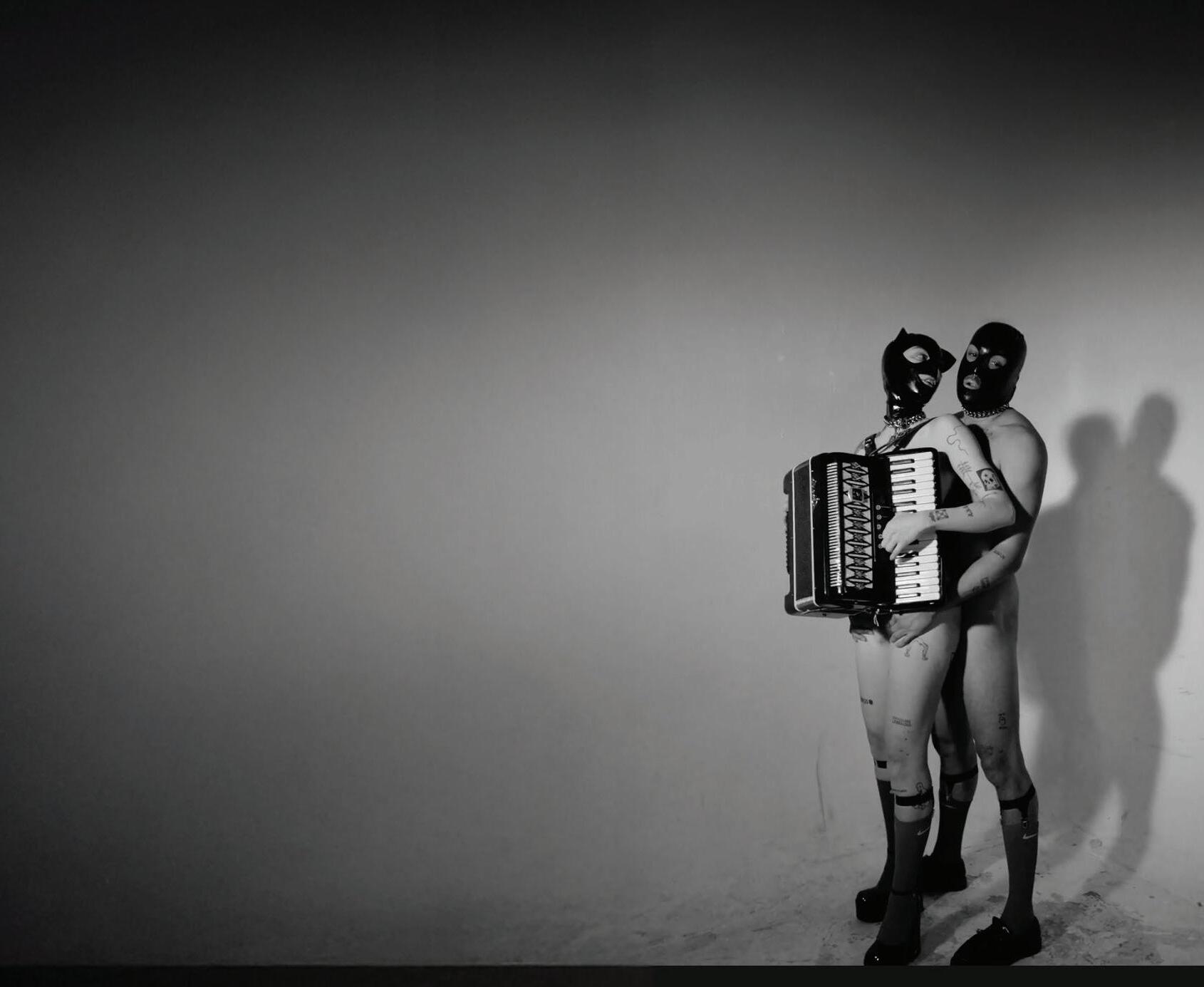




Taking your show on the road doesn’t have to be a drag.
By CHARLI RENKEN
Next month, I travel to Saint Louis for my very first out-of-town gig. While I saw a few drag shows during college in Santa Fe and have been once to Denver’s Hamburger Mary’s, the bulk of my drag experiences and all of the burlesque shows I’ve seen have been in Chicago. I only really know the etiquette and norms of the scene that birthed Vicious Mockery (my drag persona), so I thought before I head south to check out Mound City’s cabaret scene, I’d talk to some performers about what they love (and don’t) about traveling for gigs.
Burlesque dancer Willy LaQueue has traveled a lot for performances all over the world. When I spoke to him for this article he was lounging somewhere in New Orleans where he was doing a few gigs before flying back to Chicago for Inferno at the Newport Theater, and then back to New Orleans again for a private event the following morning. While exhausting for sure, LaQueue didn’t seem bothered by it.
“I love traveling. It gives me the opportunity to see places I wouldn’t otherwise,” he says.
burlesque scene, going somewhere you might not know anyone can get you out of your comfort zone and remind you why you do what you do.
“The best out-of-state show I ever did was Des Moines Pride, and it was just really heartwarming to see how people came out from neighboring states,” says drag and burlesque performer Harley Go’Lightly. “There’s nothing like a small-town crowd. They’re hungry for it. Places like Rockford here in Illinois, they also go hard for drag in the middle of fucking nowhere.”
Unfortunately, performing in smaller areas
why D’Cameron May, a trans, Black, and Pakistani drag king, typically sticks to large and midsize cities.
“I’m more of a city slicker, not because I don’t think small towns deserve drag, but unfortunately, I’m a little hesitant to travel to new, small cities on my own,” he says. “I’m from the south so I’m very aware of sundown towns. I’ve had some beautiful experiences in small towns. I’ve seen a lot of drag in small towns, but personally I have not had a lot of opportunities where I’ve been invited to them or felt safe enough to advocate for myself in those types of areas.”
Pay for traveling gigs is another thing to consider when hitting the open road. Compensation varies from town to town and show to show. Some shows o er a travel stipend on top of a booking rate, while others pay just a normal booking rate or a higher booking rate to account for traveling expenses.
When it comes to lodging, some producers can a ord to put a performer up for the night, but others don’t have the budget.
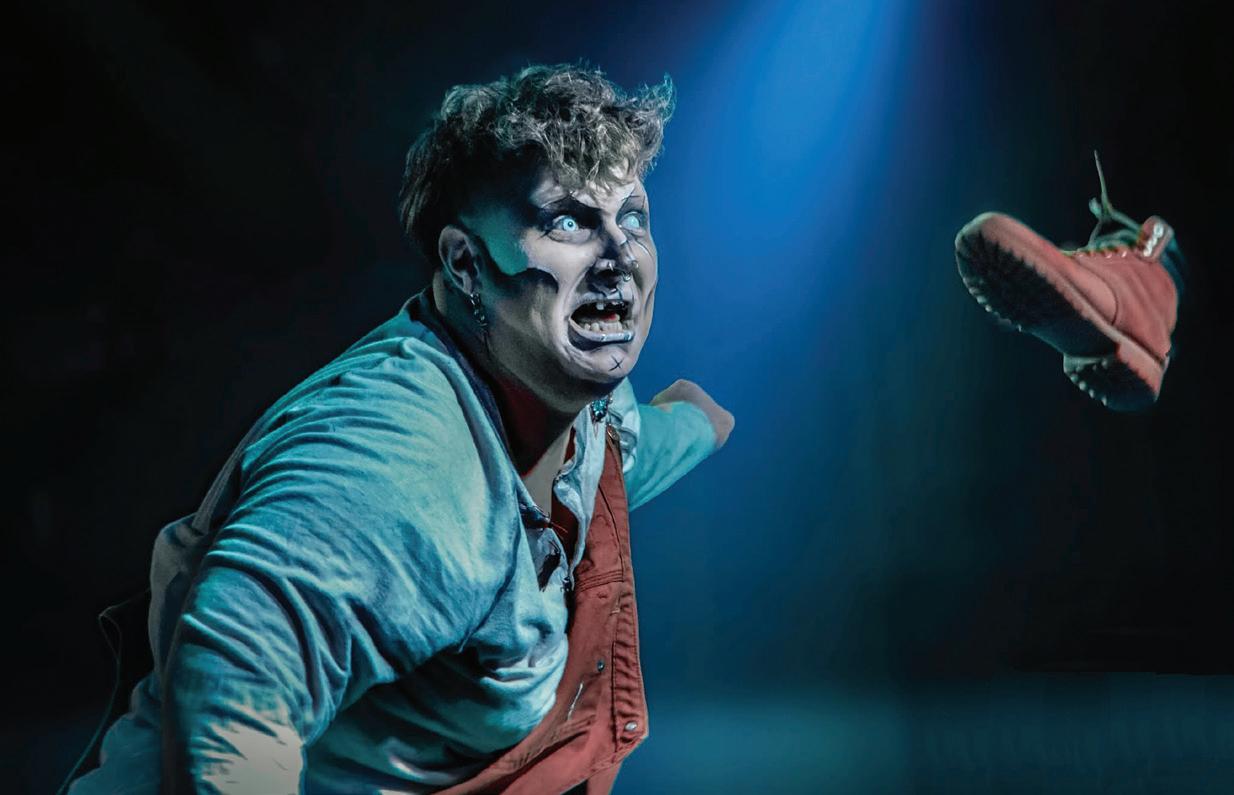
One thing many performers I spoke to expressed about traveling was that it takes them out of the bubble of the Chicago scene to get perspective somewhere else.
“Doing your work in other cities can kind of decenter you a little bit and remind you how different audiences can be,” says burlesque dancer Joelie Folle. “You may have an audience built up in Chicago, and they know what to expect. But when you go to another city, they may not know you, and you have to do the very honest work of winning them over.”
With Chicago having such a bustling drag and
isn’t for everyone. For many transgender and non-white performers, it doesn’t always feel safe to travel to those areas for shows, especially lately with violence against marginalized groups on the rise. (For example, GLAAD released a report in June showing that there has been a dramatic rise in anti-trans hate incidents, with 52 percent of the anti-LGBTQ+ hate crimes reported specifically targeting trans and gender-nonconforming people. Black and Brown people are also more at risk with Immigration and Customs Enforcement roaming the streets.) That is a large reason
“I’ve slept in many drag rooms,” May tells me, referring to the room some performers have dedicated to all their drag costumes and props. “Depending on the city, my accommodations will change. Sometimes I’ll stay with friends. Whenever I’m in New York, I usually stay at a hotel, or if one of my friends in the theater industry is available, I’ll stay with them.”
It isn’t always easy, of course. Packing can be a nightmare—especially when you have big props or delicate costumes to think about.
“If you’re any type of person who struggles with executive function, packing for out-of-state gigs is hard because you always have to anticipate things,” LaQueue says. “You’ve got to pack a backup outfit, a little walk-around [the venue] outfit, you have to think about the portability of costumes. I have an act where I have this box-looking thing made out of foam and magnets that’s meant to fall apart onstage. I used to travel with it but it was a pain in the ass, so then I started making it wherever I was traveling to, spending an hour outfitting this box to work for the act. And I was just like, ‘I can’t do this anymore. I can’t be at Home Depot trying

Noteworthy drag, burlesque, and variety shows in Chicago
Some venues have age restrictions or recommendations. See venue website for complete information.
TWILIGHT AFTER DARK: A BURLESQUE PARODY 11/6 -11/22 Thu–Sat 8 PM, Theater Wit, $ 45
HO DOWN CUNTRY NITE Thu 11/6 8 PM, Hamburger Mary’s, $ 5 (plus $15 minimum purchase)
STRAPPED FEATURING KING OF DRAG SEASON ONE WINNER KING MOLASSES Fri 11/ 7 10 PM, Empty Bottle, $26 78 -$ 33 17
MURRAY HILL: LIVE IN PERSON with special guest Tenderoni, Sun 11/9 7:15 PM, Den Theatre, $ 30 -$ 40
BUTCHER’S BIG CHOP: TOP SURGERY FUNDRAISER Fri 11/ 14 7 PM, Movement on Montrose, $12 51 (masks required)
RAKS INFERNO: CIRCUS BURLESQUE Fri 11/ 14 7 PM, Newport Theater, $ 32 78 -$ 43 45
WAYOUT WEDNESDAY FOUR-YEAR ANNIVERSARY SHOW Wed 11/19 8:30 PM, Way Out Bar, free
HOT TAWDRY PRESENTS: HOUSE OF BURLESQUE Sat 11/22 9 PM, Foundation Room at House of Blues Chicago, $24 THE VEIL BETWEEN Fri–Sat 11/28 -11/29 9:30 PM, Newport Theater, $15 -$ 55
to buy a cardboard box to be a prop!’”
With all the ups and downs of being a traveling performer, there’s a reason so many still do it.
“For me it hearkens back to the idea of the circus coming into town, which is a magic that we don’t really have anymore,” Go’Lightly says. “As someone who is kind of a lifelong student of the freak show or sideshow, it’s something I have a deep reverence for. It’s the mythos of the traveling show person. If I could have my way, I would live out of a suitcase and travel the country making weird art and being a local cryptid that only comes out on the full moon.” v
m crenken@chicagoreader.com
Two great voices in 20th-century literature come together in The Baldwin|Giovanni Experience
Earlier this year, TimeLine Theatre presented a site-specific staging of Debate: Baldwin vs. Buckley, drawing upon the transcripts of a 1965 debate between James Baldwin and William F. Buckley at the Cambridge Union. For The Baldwin|Giovanni Experience, Fleetwood-Jourdain Theatre’s artistic director, Tim Rhoze, and his wife, Bria Walker-Rhoze, turned to source material where Baldwin engaged with someone far more worthy of his time: poet Nikki Giovanni.
Inspired in part by the 1971 conversation of the two writers on the television series Soul!, the show is a heady collage of poetry, dialectics, personal reflection, movement, and music. Some of the conversation was also captured in the 2023 documentary, Going to Mars: The Nikki Giovanni Project and it’s fascinating to see Rachel Blakes embody the younger Giovanni onstage here. She’s well matched by Sean Blake (who, along with Kara Roseborough, also choreographs the movement sections) as Baldwin, who brings avuncular warmth and probing wit to his questions for Giovanni.
The generational differences between the two artists are clear (at the time of the show, Giovanni was 28 and Baldwin 47), but so is the love and mutual respect they bring to this exploration of racism, religion, revolution, oppression (including, as Giovanni makes amply clear, the abuse some Black women suffer at home), and the glorious flowering of the Black Arts Movement, which of course owed a debt to Baldwin. And as Blake’s Baldwin acknowledges here, he in part stood on the shoulders of Chester Himes and Richard Wright. (Baldwin’s falling-out with Wright over his critiques of the latter’s Native Son in his 1949 collection of essays, Everybody’s Protest Novel , gets some attention here.)
For those who don’t know the full canon for either writer (and both were of course prolific), the show is a lovely introduction to the essence of their worldviews, without ever trapping them in the narrow boxes where others (especially white critics, as Blakes’s Giovanni observes) would like to keep them confined. Preshow music by pianist Isaiah Jones Jr. and singer Mardra Thomas and the murals of Sholo Beverly add aural and visual textures to this smart and soulful celebration of two of the most important writers of the 20th century.
—KERRY REID THE BALDWIN|GIOVANNI EXPERIENCE Through 11/16: Sat 7 PM, Sun 3 PM; Noyes Cultural Arts Center, 927 Noyes, Evanston, 847-866-5914, fjtheatre.com, $32
The Conspirators go to the Marx Brothers well for their latest satirical clown show.
Are we living through a more malevolent version of a Marx Brothers movie right now? That’s the premise laid out by the Conspirators in their latest, Duck Soup!, adapted by Sid Feldman from the original 1933 screenplay by Bert Kalmar and Harry Ruby, and directed by Wm. Bullion.
Past work by the Conspirators (who use a neo-commedia technique they call “the Style,” originally developed by the Actors’ Gang in LA and John Cusack’s New Crime Productions) has landed in the darker
realms of Dante (2023’s Commedia Divina: It’s Worse Than That) and Friedrich Dürrenmatt’s The Visit (2024’s Viva la Mort). The tension between the generally lighthearted anarchy of the source material here and our current malaise doesn’t always hold up: yes, Groucho Marx in later life was a game show host with You Bet Your Life, but that hardly makes him the equivalent of a reality-TV star with fascist underpinnings taking office. Basically, the Marx Brothers may be too delightful to warrant the comparisons to the dangerous nihilist idiots running the ship of state now.
On the other hand, it’s hard not to see similarites between Freedonia (“Hail, Hail, Freedonia, land of the free, and free!”) and our own dumbocracy, where people are eager to let loose the panthers for a veritable phizzog feast as long as their baser prejudices are catered to by the people in power. The ease with which Mitchell Jackson’s Rufus T. Firefly (the Groucho part in the original) slides into office with generous support from wealthy widow Gloria Teasdale—played to the hilt by Hayden Hartrick in his best Margaret Dumont impersonation—makes it clear that we too o en end up with the best government money can buy. The presence of Ambassador Trentino of Sylvania (Vi Burnette) and his daughter, Vera (Oline Hale, sporting Natasha Fatale’s accent from the Rocky and Bullwinkle cartoons), inevitably makes us think of malign influences from abroad in the Oval Office (who are probably underwriting that godawful ballroom, which also gets a joke here).
A er a few hiccups, the show settles into a solid slapstick rhythm, greatly aided by Deacon Leer’s Chiccolini (the Chico role) and especially Sarah Franzel’s delightful silent turn as Pinky (the Harpo part). Ryland Gigante’s live percussion accompaniment (and occasional snippets of unintelligible telephone dialogue) adds charm and whimsy. These may not be charming and whimsical days, but at least these Marxists know that sometimes you just have to laugh at the foot of the gallows. —KERRY REID DUCK SOUP! Through 11/23: Thu–Sun 7 PM; Stars & Garters, 3914 N. Clark, conspirewithus.org, $30
The Pilon is a smart and heartfelt portrait of fandom and friendship.
Really good playwrights know how to take the arcana of a specialized world and make it feel universal and immediate. Based on The Pilon, now in a terrific world premiere with Red Theater, Zach Barr is such a playwright. Set in a collectibles shop in Seattle’s Capitol Hill neighborhood, Barr’s play follows a group of enthusiasts who bond over their love for cards, especially basketball cards. Corbin (Rio Soliz Ragazzone) runs a Twitch livestream from the shop, founded by his aunt Rhonda (Delia Kropp). He’s assisted by choleric Marc (Josh Razavi), whose interest seems more mercantile than personal—in contrast to Lex (Jo Tannous), who just collects what he likes, including vintage Shirley Temple cards. (As Rhonda notes at one point, “Not everyone is trying to make a retirement portfolio out of cardboard.”) Young Griffey (Harper Levander), a transmasc kid just getting into collecting, rounds out the group. When a very rare basketball card (the source of the play’s title) comes into the store, the relationships become more complicated than just the love of the game and its ephemera. Barr’s play, directed with an adept hand by Jessica Love, gives us time to adjust to the language of this world (I had no idea what a “slabbed” card meant prior to this show), while making
it clear that the store is a stand-in for a lot of places where, as one character notes, “It’s rules that keep people out of the hobby.” Manuel Ortiz’s set and Chas Mathieu’s props in the small Edge Off Broadway space add cozy verisimilitude.
Barr’s play is wise and warm, with many lovely exchanges providing important insights. It’s clear, for example, that Rhonda, who is also trans, is a source of support for Griffey, but she’s also smart enough to see that Lex and Corbin have a bond—even if the latter hasn’t picked up on the former’s attraction yet. The generational connections that collecting provides (Rhonda treasures a baseball card from her father, and collecting cards is also something that Griffey’s dad does, though the boy isn’t ready to share that part of his life with him yet) also feel resonant and honest. Barr never strains to make their points. Instead, they create a place where the slightly off-kilter collectors can find home and identity, even if it doesn’t bring the immediate riches of a rare find. In that way, The Pilon mirrors the sensation of opening up a fresh pack of trading cards. The treasures you find in life may not be the ones you thought you were looking for.
Chicago International Latino Theater Festival. —KERRY REID UZ, EL PUEBLO Through 12/14: Fri–Sat 8 PM, Sun 3 PM; Aguijón Theater, 2707 N. Laramie, 773-637-5899, aguijontheater.org, $36.70, Belmont Cragin neighbors $13.24, limited number of “theater for all” tickets each performance for $16.30; in Spanish with English titles
The Wash airs out the story of the 1881 Atlanta washerwomen’s strike.
—KERRY
REID THE PILON Through 11/23: Mon and Thu–Sat 7:30 PM, Sun 3 PM (Mon industry night); Edge Off Broadway, 1133 W. Catalpa, redtheater.org, $30 (limited number of $10 access tickets, $50 pay-itforward tickets)
Aguijón’s Uz, el pueblo is a sardonic black comedy about faith and family.
Aguijón Theater has o en presented work that looks at the tangled lives of Latine artists, as in 2022’s Cintas de Seda, written by Norge Espinosa Mendoza and based on Sor Juana and Frida Kahlo, and 2021’s La Gran Tirana (descarga dramática) by Rey Andújar, an intense look at the life and music of Lupe Victoria Yolí Raymond, or “La Lupe.” They’ve also never shied away from epic and bloody family tales, as with Andújar’s Adverses
In Gabriel Calderón’s Uz, el pueblo, directed by co-artistic director and managing director Marcela Muñoz, family drama moves into the pitch-black satire end of the color chart. Set in the eponymous town, the story seems initially like an outtake from the 1998 film Pleasantville, with housewife Grace (Ana Santos) and her daughter, Dorothy (Kris Tori), in 1950s crinolined dresses, while husband Jack (Sándor Menéndez) totes a metal lunchbox and son Jose (Oswaldo Calderón) works on his biceps with a laughably small hand weight. But when Grace, who recently lost her job at the church, gets a message from God telling her she must prove her faith by killing one of her kids (he eventually lands on Jose), things rapidly spin out of control. Every piety about family life and faith gets run through the narrative meat grinder here.
Nosy neighbors, a lascivious priest, and an irate (and accident-prone) butcher and his daughter also get sucked into the violent vortex of Grace’s mission/delusion. Through it all, Dorothy, who is apparently autistic, plays with a small wooden box that contains a miniature version of the family kitchen, and makes old-fashioned “telephones” out of cans and wires. Santos and Tori are in essence flipping the mother-daughter roles as Electra and Clytemnestra (or “Clitemnestra,” as she was called) from last year’s Adverses. Under Muñoz’s discerning hand, the ensemble delivers sharp-elbowed performances that dance on the precipice between archetype and cartoon without toppling over. It’s a terrific addition to this year’s lineup for the Destinos:
The definitions of “working class” and the depictions of labor organizing in the U.S. in popular culture so o en seem to be built around men—particularly white men. For that reason alone, Kelundra Smith’s The Wash, now in production with Perceptions Theatre as part of a rolling world premiere with the National New Play Network, deserves praise and attention. Smith, who is also a theater journalist and critic based in Atlanta (full disclosure: we have served on committees together with the American Theatre Critics/Journalists Association), brings the too-little-known story of the 1881 Atlanta washerwomen’s strike to life with wit, warmth, and a refreshing absence of didactic grandstanding.
Directed by Perceptions’s cofounder and artistic director Myesha-Tiara, The Wash captures the events around the strike through the entwined lives of five Black women and (later) one white woman. Anna (Nikki Carpenter) is a widow who runs a laundry business out of her home, though she dreams of having her own cornbread wagon instead. Jeanie (Audrey D. Allen) is her tart-tongued friend, prone to gossip, especially about the younger women who work with them: Thomasine (Myah “MJ” Jackson), who too o en shows up with a bruised face; Charity (A’Keisha Lee), whose happy marriage is only marred by the lack of children; and Jewel (Rita Wicks), who takes classes at a local college and whose rumored attraction to other women gets tongues wagging.
When the women grow tired of being paid in beans, rice, and moldy produce instead of the promised cash for their backbreaking labor, they form the idea to go on strike, betting that the white people and “highfalutin Negroes” of Atlanta, who make up their customer base, literally won’t want their dirty laundry in the streets. They begin organizing with other women, including Mozelle (Jill Iverson), a poor white woman who works hard to earn the trust of the Black strike leaders.
Smith sprinkles the story with remembrances of life lived under slavery and hints of the terror that still lurks a er dark for these women. There is an episode of violence, and the story certainly isn’t whitewashing (no pun intended) the role of race in these women’s lives, which, as one character observes, sometimes “feels like the biggest thing there is. It swallows us.” But the dream of being able “to walk in a room and have nobody assume I’m there to clean it,” as well as the dream of making enough money to live with dignity, to finish an education, to visit a new grandbaby in Rochester, or to get away from an abusive man, all combine to motivate these women. They are inspirational because they are so very relatable, down-to-earth, and use the starch in their spines to raise each other up when it’s all on the line. The strike was 144 years ago, but the story feels fresh and urgent today. —KERRY REID THE WASH Through 11/30: Wed–Sat 7:30 PM, Sun 2 PM; also Sat 11/22 2 PM; no show Sat 11/8 or Wed–Thu 11/26-11/27; ETA Creative Arts Foundation, 7558 S. South Chicago, perceptionstheatre.org, $25.63 v
By KAT SACHS
If the Black Harvest Film Festival were a restaurant, jada-amina wouldn’t necessarily be in the kitchen. “I’m not the chef,” the festival curator says. “I’m not in Premiere Pro; I’m not shooting these films. I’m setting the table. I feel like a nutritionist as well because I am making sure that people are fed— that there’s balance.”
The Black Harvest Film Festival, now in its 31st year, takes place November 7–16 at the Gene Siskel Film Center. This year’s lineup is a smorgasbord of Black cinema spanning the diaspora: a healthy mix of shorts programs (including a community film workshop showcase); narrative features; documentaries; and even some repertory highlights, such as Jessie Maple’s newly restored 1981 film Will, the first independent feature-length film to be directed by a Black woman. I spoke with jada-amina, now in her third year of programming the festival, about attending Black Harvest since childhood, her curatorial vision, and her favorite cinematic morsel this year.
This interview has been edited for length and clarity.
Kat Sachs: In past interviews, you’ve spoken about growing up on the south side and attending the festival as a kid. Why did you decide to get involved with the festival?
jada-amina: Unlike many people, I was exposed to arts and culture [growing up]. My mom exposed my sister and I to so much. All Black people come from artists or alchemists, as I like to say. Understanding that creativity is a true resource is something that was instilled in me, and it’s principal to Black Americans and so many cultures. It’s the pulse of humanity, it’s what keeps us connected.
I always knew a life where there were Black artists and Black storytellers because I was in those spaces. Seeing Sergio Mims [cofounder of the Black Harvest Film Festival] host a Q&A in the mid-2000s meant a lot to me. I never had to question if Black people were capable of having our own spaces or doing public speak-
ing. That’s the power of representation; it gave me the confidence to feel like I belonged.
[I’m] a descendant of Black folks from Louisiana. [We’re] Louisiana Creole, which speaks to the vastness of what it means to be Black in the U.S. Also, I come from sharecroppers. My grandparents met each other and moved to Chicago as part of the Great Migration. Like so many folks in Chicago, I know this festival is founded on that [history of diverse Black lineages]. It means a lot to steward it.
How do you put the festival together each year? Do you start with a theme, or do you wait for themes to emerge?
It’s really about chance, and chance is such an impossibility. I’ve learned recently that if you sit still and bear witness long enough, you’ll figure it out. Because I promise: There are hardly any coincidences in this universe. I think Black Harvest is a testament to this.
[Curating] is about feeling for me. Ideally I’m creating a space more than presenting a festival. I often refer to Black Harvest as a reunion. The idea of reunion is super valuable to Black folks because we were split up during

enslavement. I had a screening where one of the film’s writers brought their niece, who had been in foster care and was later adopted, and she met her grandmother for the first time [at that screening]. I mean, that has nothing to do with the selection process, but it also does. I selected that one, and that [reunion] happened in our theater.
You’ve described your curatorial approach as “liberatory.” What does liberation look like in your film programming?
My idea of liberation is certainly not everyone’s, and I’m aware of that. I create a program that feels liberatory in that it’s safe to express [taboo] cultural a nities and be problematic. The topic of stereotypes is controversial.
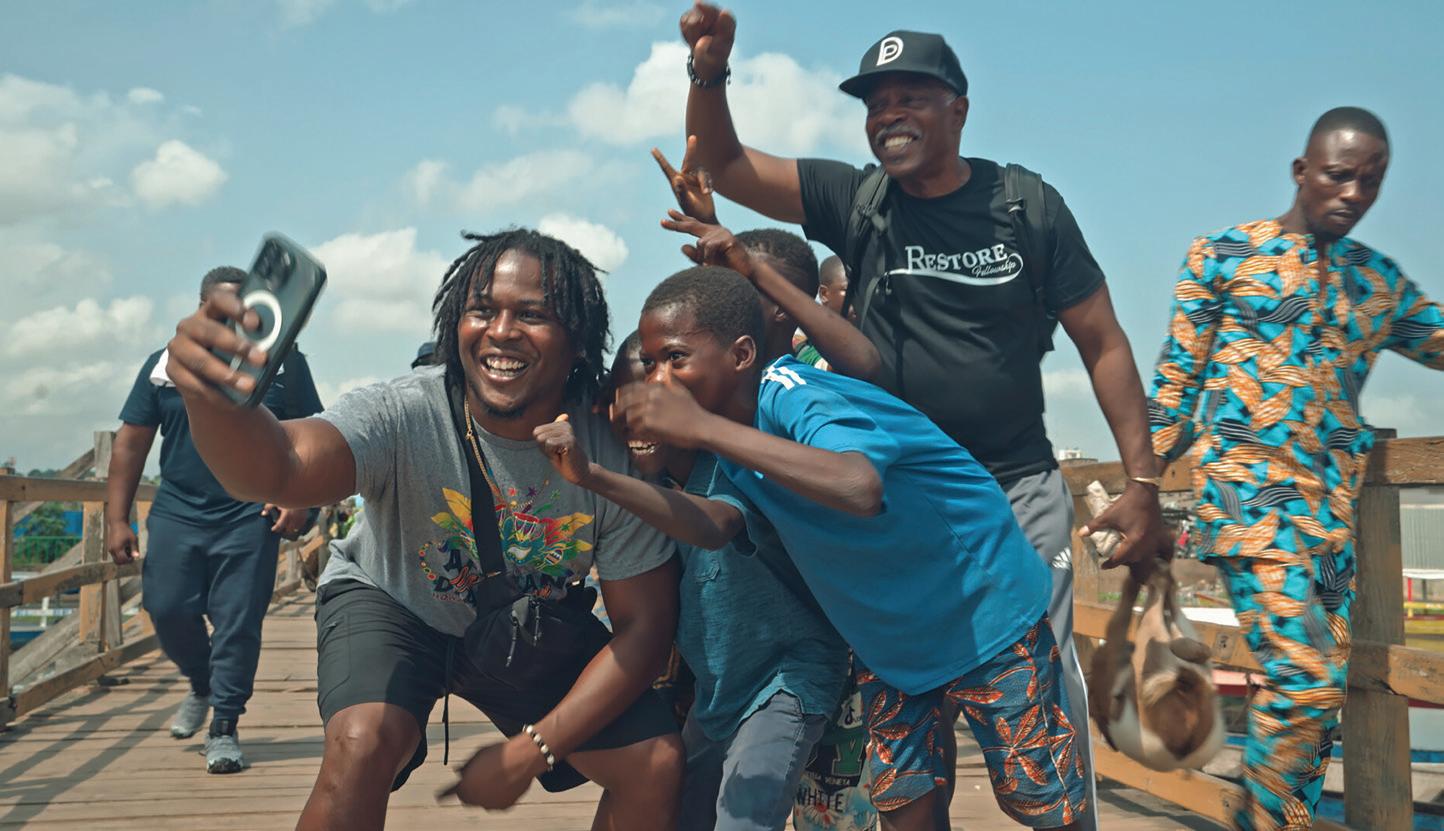
Stereotypes are distorted [views of people and culture], but they do have resonance and truth within them. Black people do enjoy fried chicken. Why are you weaponizing that? Black people do enjoy watermelon. Why is that a weapon? Respectability, stereotypes, and these charged ideas of representation—they come up. In my programming, there’s not just one narrative.
Can you talk about a film in the upcoming lineup that changed or surprised you and why?
The closing night film, Black Girl (1972) by Ossie Davis. It’s about a Black girl in Los Angeles [and the changing roles of women during the emergence of the Black Power movement]. But it could be seen as a story about a Black woman living in the wake of enslavement. Back in 1972, the books that were coming out referred to African American or Black American people only as “he.” [Black women] just weren’t acknowledged. It was like race was the Black man’s issue. Seeing that in this film really struck me.
[Growing up,] my grandma told me she didn’t vote until 1966, and that really pissed me off. I remember thinking, “Everyone else votes but not Black women.” We were the last of the American citizens. And thinking about this film . . . I can’t imagine being 18, reading a book, and seeing “he this,” “he that,” everywhere. My sister, my husband, my grandma, and me, we all carry pieces of that history. v m letters@chicagoreader.com





Whenever people ask me what I did over the weekend, it can be anticlimactic to say that I saw several movies. Maybe I went to several different venues and saw multiple genres (some even on celluloid!), as well as numerous people. That’s very exciting to me, but it feels boring to say, “Oh, I just watched some movies.”
This past weekend ended up being more of the usual, but of course, actually loving film can look decidedly unusual. On Saturday, I went to Home Movie Day at the Chicago History Museum, copresented by the Chicago Film Archives and the Chicago Film Society. It’s an annual, approximately four-hour event where these film institutions inspect and project home movies brought to them by the general public. These movies are part of their personal or family histories. In her introduction to the book Mining the Home Movie: Excavations in Histories and Memories, Patricia R. Zimmermann wrote: “Home movies constitute an imaginary archive that is never completed, always fragmentary, vast, infinite.” I’d only attended one before, in 2021, and I came in its final hour, when participation was dwindling. This year I left an hour before it ended, and it was still standing room only.
A mong the screenings were some amateur films. One gentleman brought a short he’d made while in film school in the late 60s/early 70s, an homage to George Romero’s Night of the Living Dead (1968) with a lone zombie played by an anthropomorphic vacuum cleaner. Otherwise the films were personal artifacts, of families at home, at play, on vacation. When a person’s film was being shown they’d stand up and talk about it, oftentimes being moved to tears reminiscing about late family members. One woman’s grand-

Still from home movie Joan Beauty Shots, Joan & Diana Tennis (1941–1973)
WARREN LIEB COLLECTION/CHICAGO FILM ARCHIVES
mother, seen in a home movie with her mother as a young child, had just died the week prior. It was beautiful and eerie. Sometimes I’m moved to think about similar ontological issues when I’m watching older films where all the actors have passed. This felt appropriate to think about on Halloween weekend, as did how I spent my Sunday. In early October, I wrote about seeing the surrealist films of Mexican filmmaker Luis Buñuel at Doc Films. The Luis Buñuel Film Institute ended up reaching out to me on Instagram to alert me to the Buñuel exhibition on view through February 22 at the International Museum of Surgical Science. On Día de los Muertos, the museum would host an unveiling of Buñuel’s ashes, recently returned to the filmmaker’s son after being missing for decades. Who could resist? I went, and it was surreal (again, appropriate). People could leave o erings, so I unhooked the Labubu from my purse to give to Buñuel. (Surely that sentence has never been written before.)
Last week I also saw Jean Rollin’s The Shiver of the Vampires (1971) at the Alamo Drafthouse; Kelly Reichardt’s latest, The Mastermind (2025), at the Siskel Film Center (it’s an incredibly subtle fi lm, so I’m still thinking about it); and Gregg Araki’s The Doom Generation (1995) at Doc Films, for another volunteer fireguard shift. So yes, I “just” saw some movies this week—but how often does that lead to spending a day with the remains of one of cinema’s greatest auteurs?
Until next time, moviegoers. —KAT SACHS v
The Moviegoer is the diary of a local film bu , collecting the best of what Chicago’s independent and underground film scene has to o er.
RECOMMENDED
Get showtimes and see reviews of everything playing this week at chicagoreader.com/movies
Crime thriller Violent Ends is exactly the kind of film that actor James Badge Dale is known for. He’s not even the protagonist; the film is just another one of those gorgeously photographed, patiently paced dad movies that’s made the actor’s career. Here, the action is set in the Arkansas Ozarks, and Dale plays Sid Frost, a member of the Frost crime family that runs the area’s drug trade. The three brothers who started the business have found an uneasy peace, but their sons, including Sid, are clashing.
Sid’s cousin Lucas (Billy Magnussen) is the actual protagonist: an archetypal “guy who wants out.” While he’s never joined the family business, he wants to get as far away from it as possible to start a life with his fiancee, Emma (Alexandra Shipp, who has a wonderfully sweet chemistry with Magnussen). Predictably, when Emma gets hurt being in the wrong place at the wrong time, Lucas is inspired to continue his family’s legacy of violence.
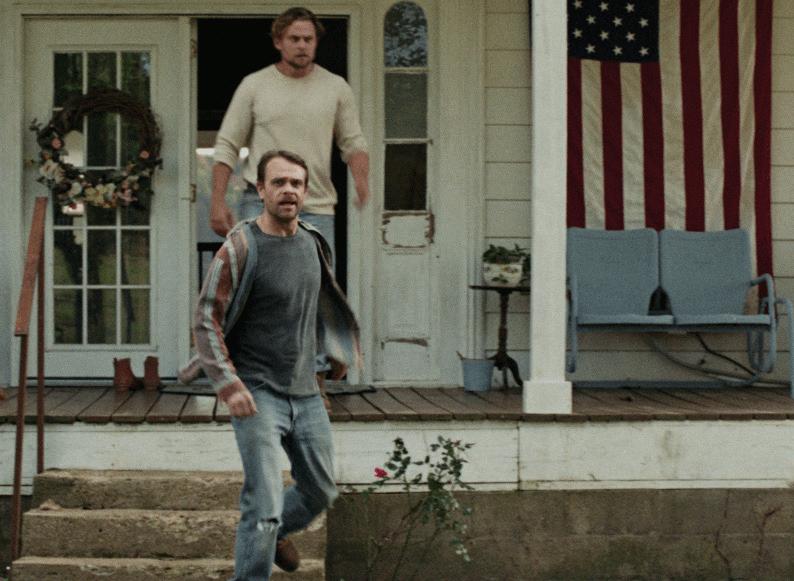

Violent Ends tries to invest in the family dynamics unique to this clan, which saves it from being an overly rote southern gothic revenge tale. But overall, it reaches for a greatness it can’t quite grasp. Writer-director John-Michael Powell is brilliant at building tension, and the whole thing looks incredible thanks to cinematographer Elijah Guess; his work is so beautiful that it o en distracts from the content of the scenes, which sometimes run thin. Despite its emotionally stirring points and good looks, Violent Ends is still too generic to be something really special. But hey, Dale fans and dads will love it!
—KYLE LOGAN R, 112 min. Wide release in theaters
Richard Linklater’s Nouvelle Vague is a cinephile’s homage to filmmaker Jean-Luc Godard and his breakout movie À bout de souffle (1960)—known in English as Breathless. In its time, Breathless set a new benchmark for filmmaking by using jump cuts, a handheld shooting style, and naturalistic acting to achieve urgency and excitement. Linklater tells a stylized, straightforward story about making the film, but does little to evoke the timelessness of its source material.
Godard (Guillaume Marbeck) is a cigarette-smoking, sunglasses-wearing film lover, and he’s the last critic
at renowned French film journal Cahiers du Cinéma to direct a film. He’s pompous, but he’s passionate enough to secure funding and shoots Breathless in 23 days. (At the time, most movies took three to four months to film.) The short turnaround is partially due to his unconventional way of working with Jean Seberg (Zoey Deutch) and Jean-Paul Belmondo (Aubry Dullin). Performance and perfection are antithetical to his idea of art, so he barely provides direction or lines. Instead, he encourages spontaneity and captures the actors at their most natural in one or two takes.
Nouvelle Vague is worth the affection Linklater gives Godard’s process, but the movie is far less interesting than its inspiration. Linklater indulges too much of his personal cinephilia, especially choosing to shoot on 35 mm black-and-white film. The core story skirts the source material’s surface, rarely offering much depth to audiences. Too much of the film dwells on various French New Wave figures, who dri onscreen, stare into the camera, deliver a line or two (maybe), and vanish seemingly without purpose. One might wonder: Is it better to skip Nouvelle Vague and just (re)watch Breathless instead? —MAXWELL RABB R, 106 min. Limited release in theaters, streaming on Netflix Fri 11/14 v
The Hallogallo scene has produced international successes—Horsegirl, Friko, Lifeguard—even as it continues to spread a grassroots DIY spirit in Chicago and beyond.
By LEOR GALIL
Musician and poet Cole “Johnson Rockstar” Hunt moved here for a summer internship in 2022. He’d just finished his junior year at the University of Texas at Austin, and he’d long loved the idea of Chicago. When he was growing up in California, his mom had regaled him with stories from her 20s about Chicago’s music scene. He’d also just learned about the Hallogallo scene, a tight-knit crew of teenage Chicago indie rockers who’d started attracting national attention.
Cole didn’t arrive in town in time to see one of the biggest Hallogallo bands, Horsegirl, headline Thalia Hall on Sunday, June 5. They were celebrating their new debut album, Versions of Modern Performance, released by venerable indie label Matador. Scene comrades Post O ce Winter, Friko, and Lifeguard opened the show. Cole got here partway through the next week, and that weekend he went to the Hidden Cove to see Post O ce Winter play a high school student’s graduation party.
“The only people there were the 18-year-olds who were graduating high school and their parents,” Cole says. “It was kind of an awkward show, but there was free pizza and beer.” Post O ce Winter, at the time a folky indie-rock trio led by Will Hu man and Charlie Johnston, closed with a cover of LCD Soundsystem’s “All My Friends.” After the set, Cole approached the band’s drummer, scene workhorse Eli Schmitt.
“He’s like, ‘I love the set, man,’” Eli says. “I’m like, ‘Who are you? You’re wearing a full suit.’ Little did I know that I’d be seeing a lot of that guy.” When Kansas band Sweeping Promises played Bric-a-Brac that same weekend, Cole showed up, as did Eli and all three members of Lifeguard—drummer Isaac Lowenstein, bassist-vocalist Asher Case, and guitarist-vocalist Kai Slater. And when Kai’s band Dwaal Troupe opened for Been Stellar at Subterranean four days later, Cole was there.
“I was able to just very quickly actually meet the people in the di erent bands and become friends within days of being in Chicago,” Cole says, “which basically changed the course of my life.”
Cole returned to Austin in August, and he and Eli began writing and recording remotely in a new band they called TV Buddha. That December, Cole came to Chicago for an in-person session. “We blindly tried to record for the first time, but we had never even played together,” he says. “So we had no chemistry or anything.”
TV Buddha released their seven-track debut, the noisy and exploratory Simple Bodies, in March 2023. After Cole graduated later that year, he moved to Chicago and became roommates with Kai and Eli. Cole also got a job as talent buyer for the Fallen Log, which he held until partway through 2024. No longer separated by a thousand miles, Cole and Eli naturally developed an easier collaboration in TV Buddha, and in December 2024, they put out a drony, euphoric
Members of three bands from the Hallogallo scene—Chicago’s TV Buddha, Indianapolis’s Good Flying Birds, and Louisville’s Parking—played Halloween shows as the Velvet Underground in all three groups’ hometowns.

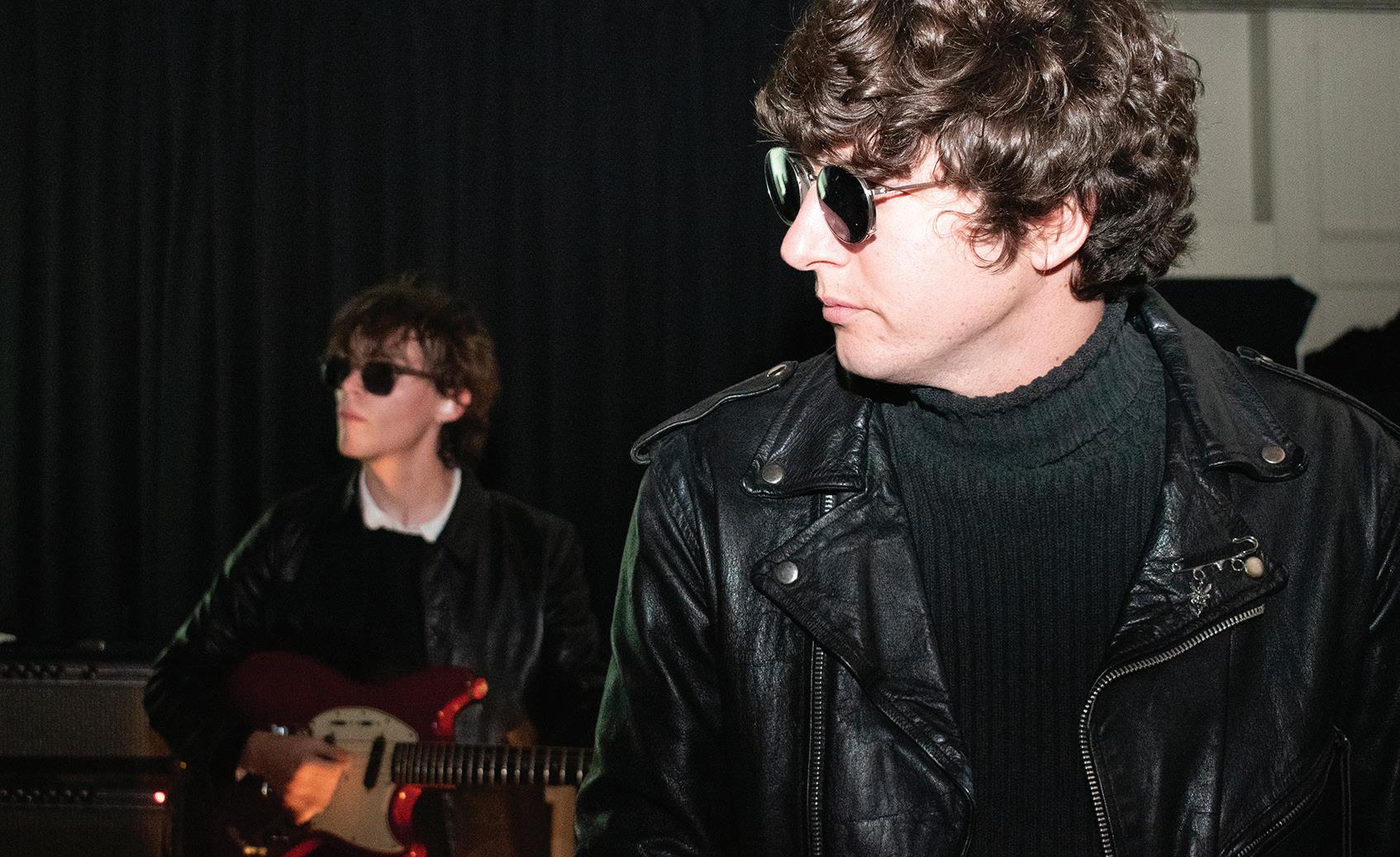
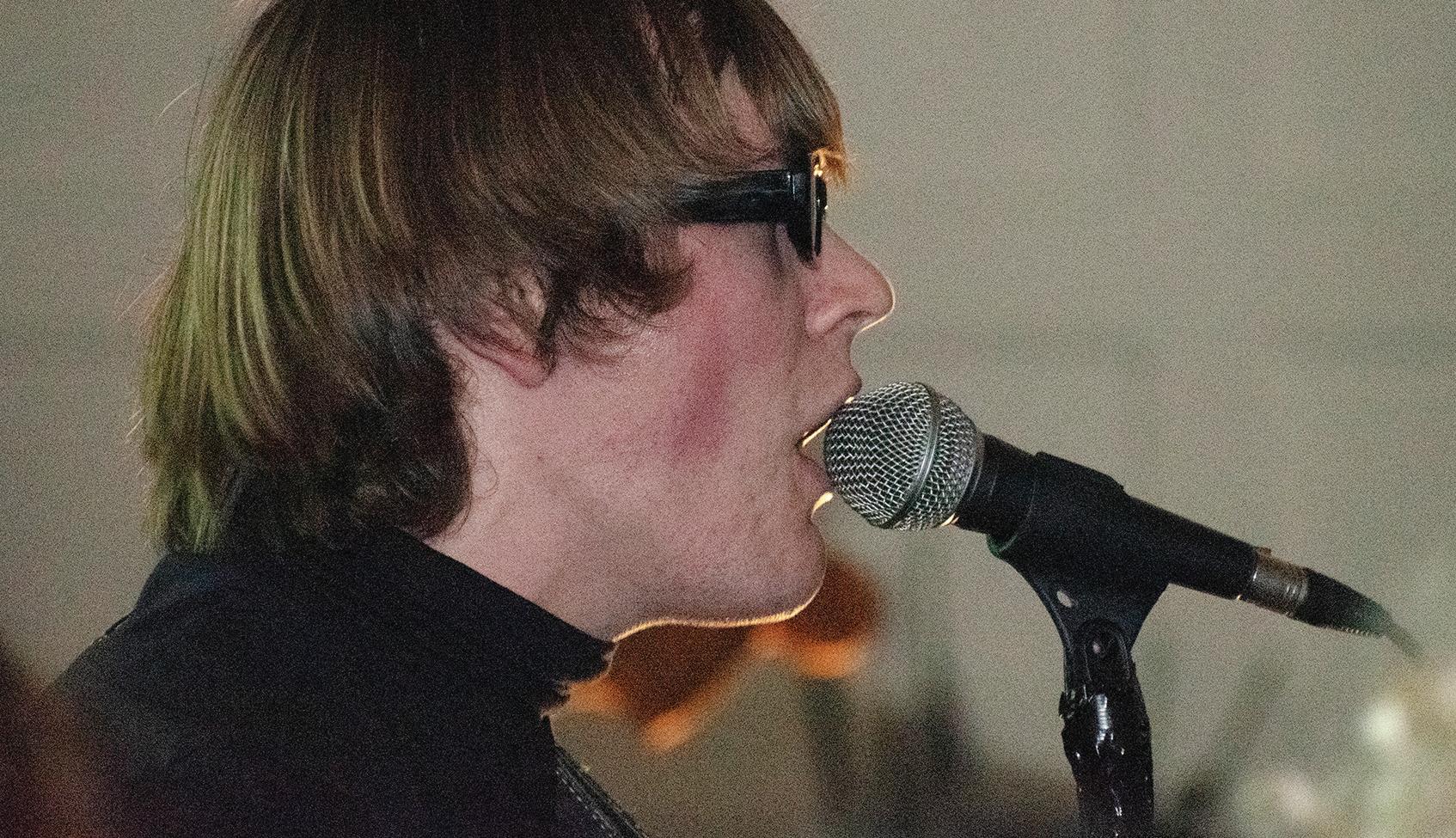
rock EP called 10,000 Buddhas , one of the best Hallogallo records to date. By then, though, the scene had changed dramatically.
“So much of what made the original small scene really special was how insular it was and how hermetically sealed it felt from the outside world,” Eli says. They see Horsegirl’s big 2022 release show as a turning point. “I think everyone was like, ‘Oh wow, this could be our lives.’”
What’s different about Hallogallo today? Since that Horsegirl show, many of the teenagers involved have of course entered their 20s. What was once a teen-oriented scene confined to Chicago has spread out and grown—and as part of that process, a split has developed between its hometown nucleus and its most successful bands. Horsegirl now call New York City home; along with Friko and Lifeguard, they’ve become critics’ darlings and toured internationally. The Hallogallo scene has also attracted artists from other parts of the country, including Texas punk band Answering Machines, Minneapolis folkie Amaya Peña, and several musicians associated with North Carolina label Trash Tape Records, all of whom have moved to Chicago.
“You can just see a great band like Lifeguard play a 20-minute set and randomly pack it up and go. I thought that was so amazing, and I felt like this was a scene that was really thriving that I wanted to start being a part of.”
North Carolina transplant Eilee Centeno of Trash Tape Records
on the road, including dates this summer on a package tour with indie elders Modest Mouse and the Flaming Lips.
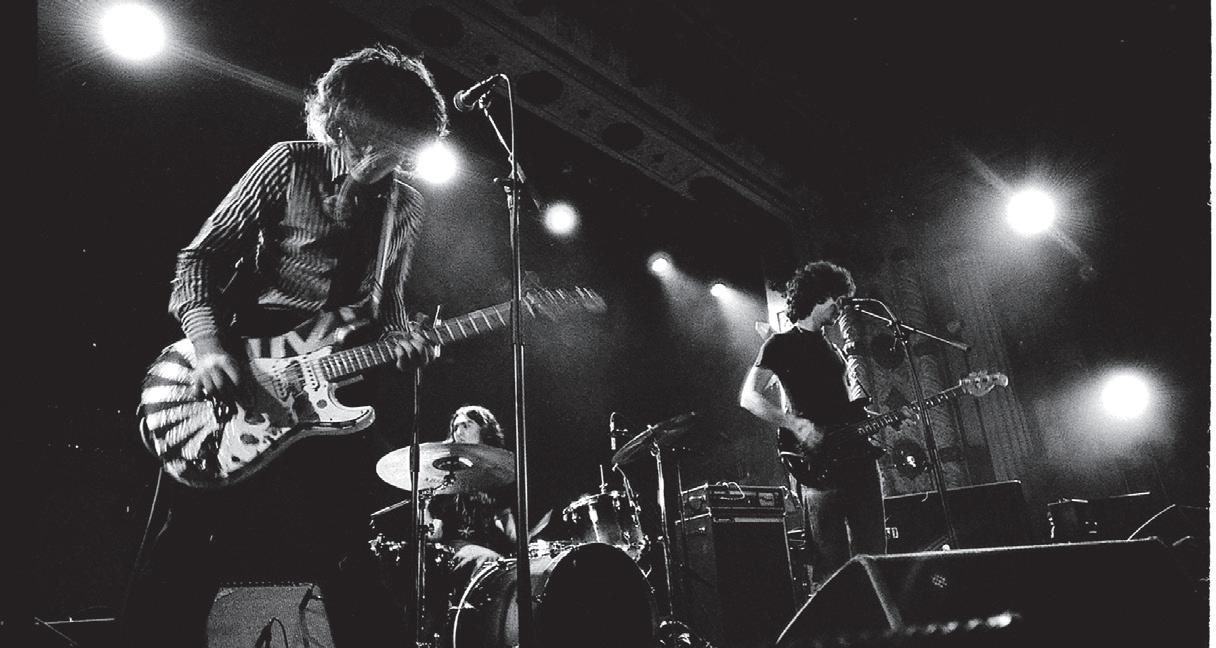
The first wave of Hallogallo bands have brought younger musicians into the scene, even inspiring some of them to pick up instruments. As Hallogallo artists tour more often, they build connections with groups in other cities, including Good Flying Birds in Indianapolis, Parking in Louisville, and Little Chair in Durham, North Carolina. One outgrowth of this expanded activity has been a two-day underground festival of bands, panels, and workshops called the Big Pop Show, held in March at the student-run co eehouse and venue on the Duke University campus in Durham. Hallogallo is seeding a new, young indie scene on a national scale, with a thriving underground and big stars whose albums are celebrated by what’s left of the music media.
In February, Matador issued Horsegirl’s second album, Phonetics On and On. Four months later, Lifeguard put out their first Matador full-length, Ripped and Torn. Friko have been relentlessly promoting their February 2024 debut album, Where We’ve Been, Where We Go From Here, released by Dave Matthews’s ATO label; front man Niko Kapetan says they’ve spent six or seven of the past twenty months
Meanwhile the scene on the ground in Chicago has grown too, with more grassroots gigs, more zines, more recordings—all of which have the potential to attract new fans and musicians. The all-ages shows Eli organizes as New Now (and records and uploads to YouTube) are no longer confined to his apartment—they’re at Color Club and, increasingly, the First Presbyterian Church of Chicago. Cole has started booking concerts under the Nitroglycerine banner. Zines such as Eli’s Unresolved and Kai’s Hallogallo continue to document the scene for the curious. The volume and variety of music coming out—whether issued by established labels with monthslong promotional rollouts or self-released on home-dubbed tapes or burned CD-Rs—has also increased, helped along by Kai’s launch of a Hallogallo cassette label and the relocation of Trash Tape Records to Chicago.
Since 2022, newer and younger acts such as Current Union TM, Uniflora, and Starcharm have expanded the scene significantly. Members of the original Hallogallo crew have also started more projects. “I’m in anywhere between three and five bands,” says former Dwaal Troupe drummer Desi Kaercher. She only lists three as currently active: a lo-fi project helmed by Ruben Steiner called Lund Surk, quasi-symphonic
indie-rock ensemble Deerest Friends, and new emo group Make Like Marigold. Some of these newer endeavors have caught on nationally too, particularly Kai Slater’s solo recording project, Sharp Pins. He self-released two albums, 2023’s Turtle Rock and 2024’s Radio DDR , before getting picked up by K Records imprint Perennial—and when Perennial reissued Radio DDR in March, Pitchfork declared it “Best New Music.” On November 21, Sharp Pins will release a third album, Balloon Balloon Balloon, which has already been covered by Rolling Stone. The Sharp Pins live band usually includes bassist Joe Glass and drummer Peter Cimbalo (aka Alga), who are solo artists in their own right. In March, Sharp Pins opened a tour for
the Hard Quartet, an indie supergroup led by Pavement front man Stephen Malkmus. Sharp Pins and Lifeguard have kept Kai on the road a lot this year, so he’s organized fewer shows locally. When he launched his mod-inspired dance party, the Hallogallo Raveup, in December 2023, he intended it to be bimonthly, but he hasn’t been able to book one since Valentine’s Day weekend.
Kai has mixed feelings about touring so much, because he believes that the shows he and his friends put together in Chicago sustain the essence of Hallogallo. “Everyone can feel it when it happens, ’cause it’s a very celebratory, explosive thing,” he says. “I feel like that’s really what Hallogallo is to me.”
Kai says he doesn’t intend to claim ownership of Hallogallo. Its beginnings are rooted

continued from p. 19
in a specific time and place, but as far as he’s concerned, anyone who wants to use the word can decide what it means to them. “The whole Hallogallo thing, it was constructed to be deconstructed in a way,” he says. “It was just this label—not in the sense of a record label, but just purely a label for this community.”
The Hallogallo spirit has spread around the country, but Chicago remains the North Star. “It’s like a headquarters or a clubhouse—or a meeting place where people go to visit and make art,” says Shannon McMahon, an NYU student who makes a zine called My Little Underground Shannon first made contact with the Hallogallo scene after interviewing Lifeguard during the final Pitchfork Music Festival in 2024. She bonded with Eli after catching a TV Buddha show in Los Angeles last winter; at the Big Pop Show, Shannon and Eli led a zine-making workshop.
The last page of the September issue of My Little Underground is a list titled “Bands to Know.” It organizes bands by state, and the state with the most is Illinois. And Shannon likes Chicago musicians for more than their music. “The people that I’ve met from Chicago are always so curious to see what else is out there—and to also spread their own art,” she says. “It has built this greater community.”
“Iremember going to those early Lifeguard, Post Office Winter, and Horsegirl shows and being really inspired,” says Kira Isbell, who drums in dubby postpunk group Current Union TM. “Seeing music in a way that it felt like something that I could be a part of and participate in.” Kira had never played in a band before discovering Hallogallo, and her younger brother, Reid, took inspiration from the scene to transform his own music making.
“I was in this one band that was space rock— like 60s kind of stu ,” Reid says. “I remember I saw Lifeguard for the first time with one of the guys in that band, and I realized that I wanted to do very di erent stu .” In 2023, the siblings launched shoegaze duo Twin Coast, with Reid on guitar and Kira on drums, and the Hallogallo scene embraced them—in January 2024, they played a New Now showcase at Color Club. Five months later, Eli partnered with Kira and Reid on a daylong festival at Schubas called New Static! Revival Now, which featured TV Buddha, Twin Coast, Sharp Pins, Isaac Lowenstein’s solo IDM project Donkey Basketball, and Uniflora. Uniflora also formed in 2023, and about three months later they played Hallogallo Fest 2.5 at Color Club in June. “When we were first starting, it was bands like Lifeguard and Neptune’s

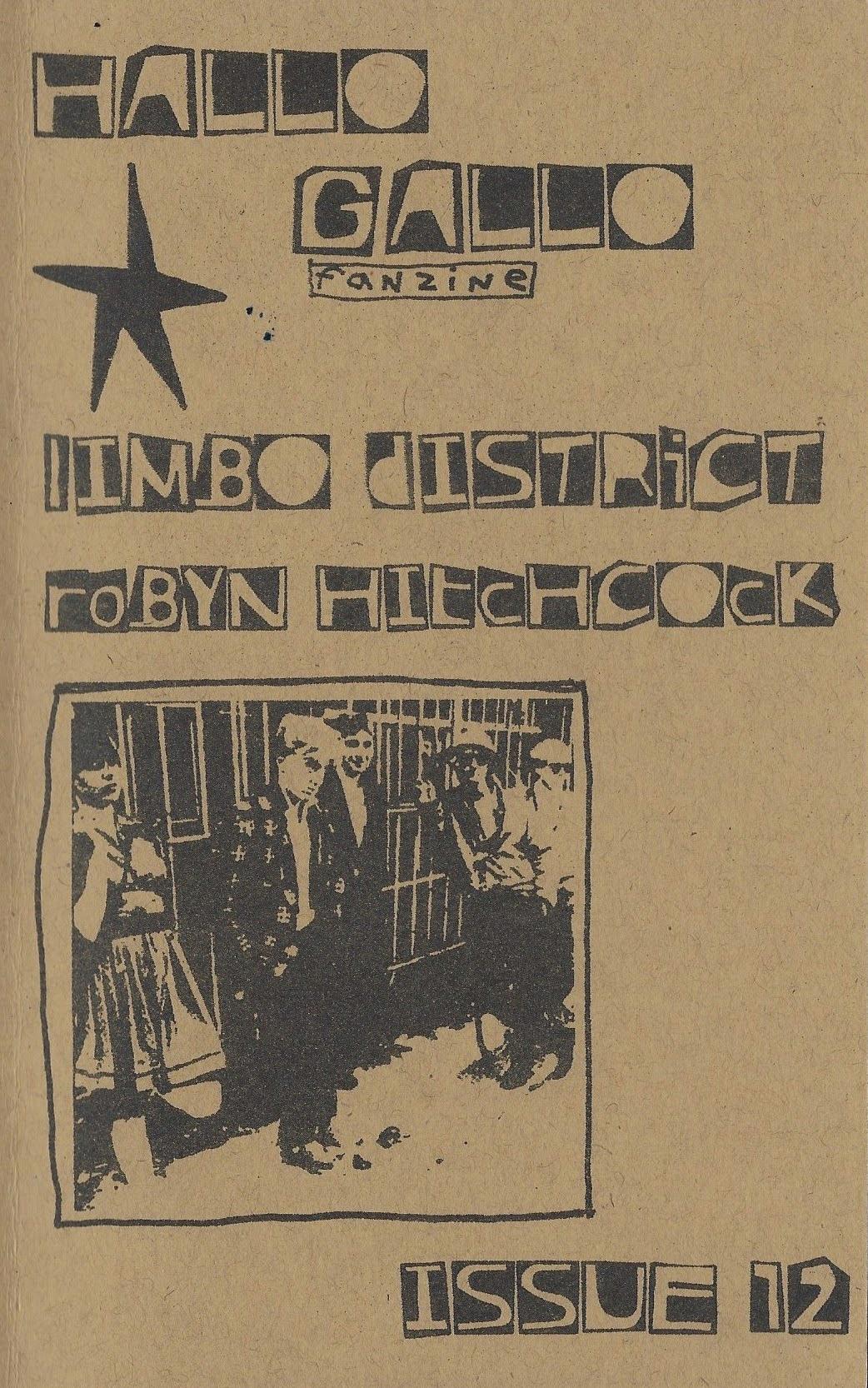
GRIZZLY BEAR, LIFEGUARD Sat 11/8, 8 PM, Salt Shed indoors, 1357 N. Elston, see Ticketmaster for prices, 17+
Core that were really giving us the resources to figure it all out,” says Uniflora drummer Ruby O’Brien. “We had the music, but we obviously didn’t know anything about the businessy side.”
Ruby is a senior at Jones College Prep, and last year she had a math class with Isaac from Lifeguard. “I remember he missed school ’cause he was prepping to play this soldout show with Jack White,” Ruby says. “I think that was the turning point for me.” Playing in a real band with a real career started to feel like something she could do.
Lifeguard seem especially good about drawing people into the scene. In October 2023, two-thirds of the Trash Tape Records crew— siblings Eilee and Evren Centeno— visited Chicago to see the label’s third owner, their friend Nathan McMurray, who’d already moved here. They managed to catch an impromptu outdoor Lifeguard set.
“I was like, ‘Wow, this is so cool— people are just setting stu up like this,’” Eilee says. “You can just see a great band like Lifeguard play a 20-minute set and randomly pack it up and go. I thought that was so amazing, and I felt like this was a scene that was really thriving that I wanted to start being a part of.”
In late 2021, when Nathan was still in North Carolina, he reached out to Post O ce Winter about joining a two-day online music festival called Takin’ Out the Trash that his label was throwing in January. This sparked a Discord friendship between the Post Office Winter crew (including Charlie Johnston’s Dwaal Troupe bandmates Desi Kaercher and Frances Brazas) and the Trash Tape Records crew.
“It was COVID,” Evren says, “so if you’re a teenager you’ve gotta be in, like, seven group chats.”
Nathan and Evren of Trash Tape met during Merge’s 30th anniversary festival in July 2019, after the Telekinesis set in the back room of the Cat’s Cradle in Carrboro, North Carolina. “Nathan was like, ‘You’re the only guy here who’s under the
age of 50,’” Evren says. “Then he gave me a pop quiz on indie bands. Then he was like, ‘We should hang. We should play music together.’” They formed an emo group called Welcome to Berlin and began practicing in a shed behind Evren’s house.
During COVID lockdown in spring 2020, they launched the label, and later on Eilee joined them.
With little else to do, Nathan focused on music. “My school was online, and it was kind of a joke, so I just stopped doing school,” he says. “I would have the school up on my computer, but I would be on Photoshop or whatever, like, while I was in class. Sometimes I’d fall asleep, and I’d get yelled at by my teachers.”

Nathan put his energy into dubbing and mailing cassettes for Trash Tape. He and Evren hunted for bands they might want to release, scouring Soundcloud, Rate Your Music, and even a forum for tape label 9733. They accepted demos too, which introduced them to future friends and collaborators such as Atlanta songwriter Awsaf Halim (who fronts Hill View #73) and Alabama rocker Henry Tartt (who fronts Memory Card, now a Chicago band).
“It was kind of like trying to manufacture a real scene in circumstances where it was impossible,” Evren says. “But then it led to us eventually moving here and eventually being a part of a scene here.” In fall 2022, Nathan moved to Chicago for college, leading to the formation of Deerest Friends, a loose collective that includes Frances and Desi. Evren followed in summer 2024, around the time Eilee graduated from North Carolina State University in Raleigh. By the end of the year, she was here too.
On February 15, 2025, the Trash Tape crew hosted the first IRL version of Takin’ out the Trash at Borelli’s Pizzeria. Deerest Friends headlined; Memory Card, in which all three heads of Trash Tape sometimes play, also performed. The event also included a zine fair, and to celebrate, fans cut into a Trash Tape cake.
“We had to wash dishes to be able to do the festival there, but it was awesome,” Eilee says. “It was a beautiful moment to me. I was like, ‘Wow, we moved, and we’re doing the thing that we said we were gonna do.’”

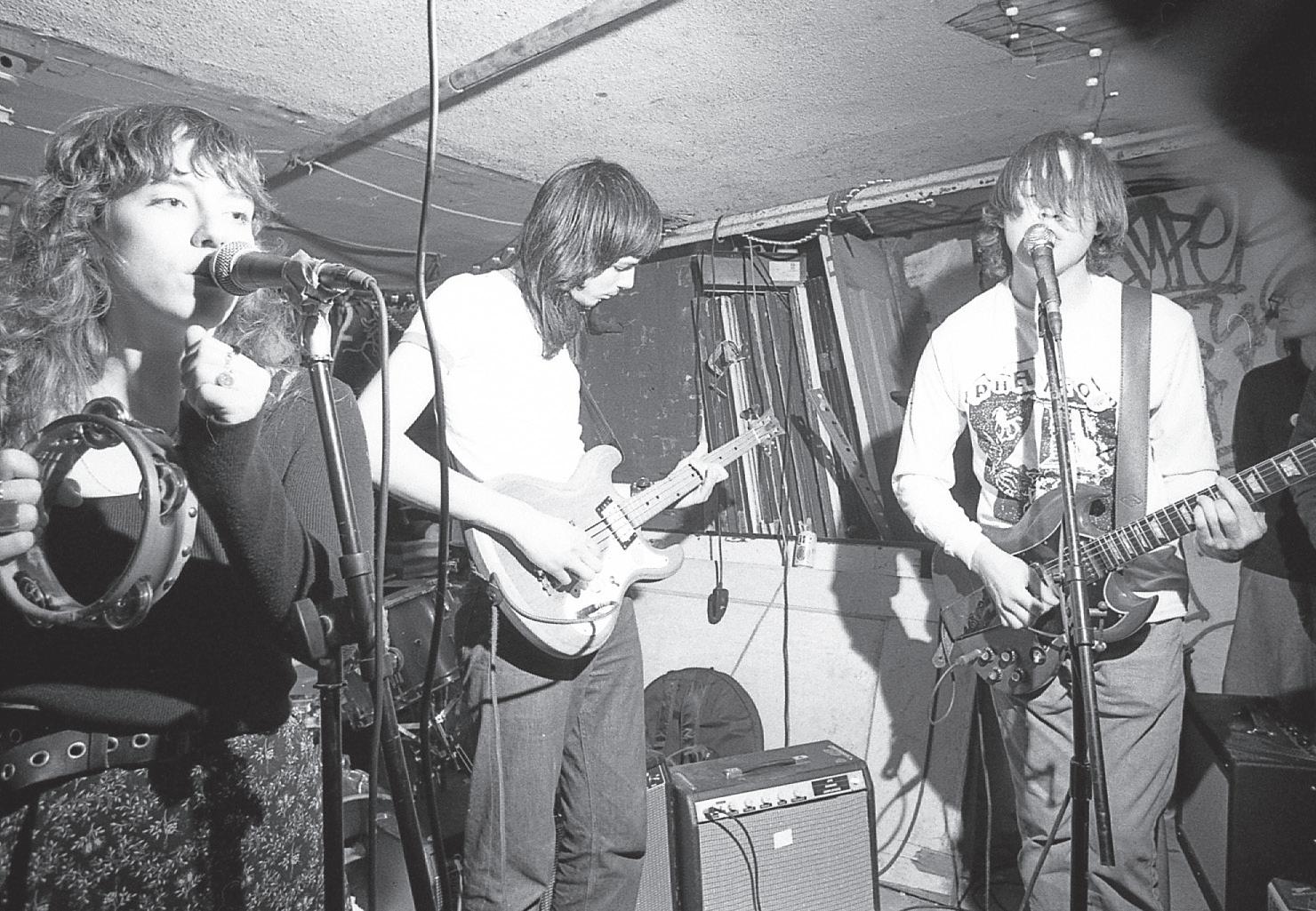
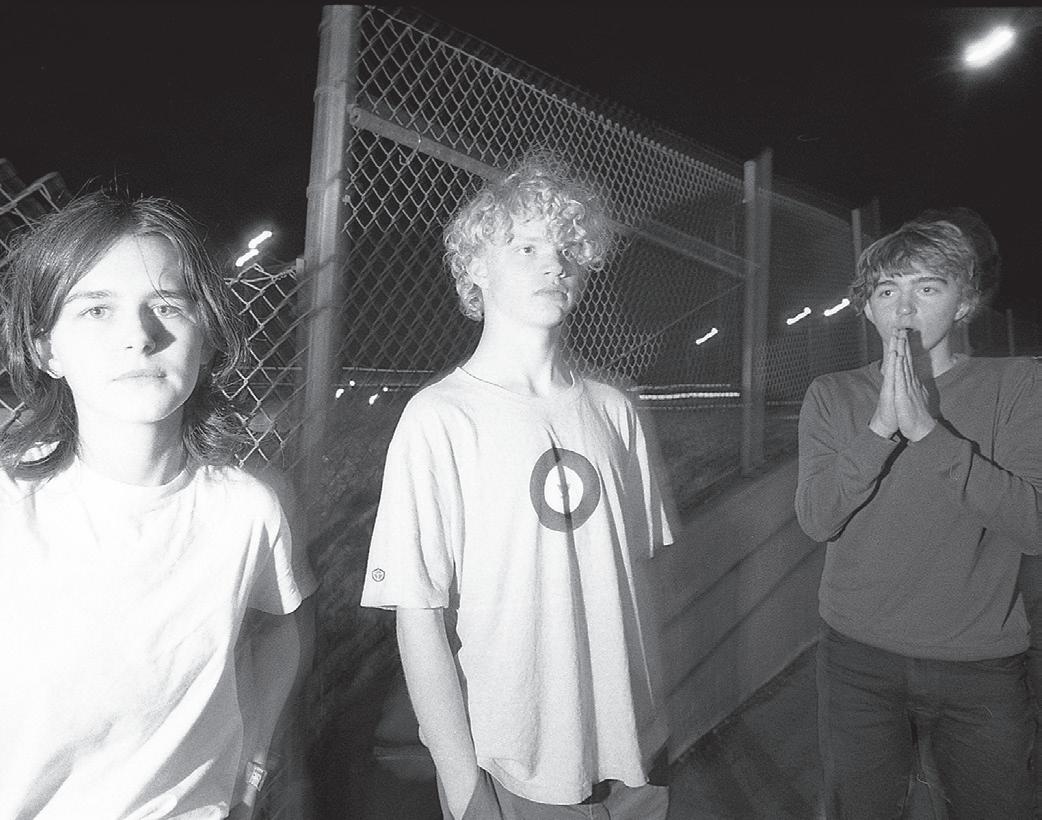

Amaya Peña intended to take a little time for themselves when they moved from Minneapolis to Chicago in 2023. But about a week later, Minneapolis band She’s Green invited them to an afterparty for a show they were playing with Chicago duo Soft and Dumb. Amaya met Cole, Kai, and Eli there and then kept running into them at concerts in the weeks to come.
“I’d really shyly stay at a show until everybody left,” Amaya says, “and then they’d be like, ‘We’re getting ice cream—do you wanna come?’”
In January 2024, Amaya made their solo debut at the Fallen Log as part of Cole’s Nitroglycerine series. A week later, Eli asked Amaya to perform for the New Now series; for the first couple songs, Amaya was accompanied by
their new best friend, Oak Park native Jasmin Feliciano, who’s also contributed to TV Buddha. She’d befriended Amaya when TV Buddha played with Soft and Dumb at Color Club the previous October.
“We walked up to each other, and we had a speedwalking contest—they won, obviously,” Jasmin says. “Soon after, we made our way to this piano in the corner of the room. We haven’t even exchanged more than a couple words, we haven’t exchanged names—we start playing piano together in silence.”
Soft and Dumb soon broke up, and half the duo, Elena “Lanie” Buenrostro, brought Amaya into a new project called Starcharm early in 2024. Elena recalls asking Amaya to hang out after Friko’s acoustic record-release set at Shuga Records in February 2024.
scavenger hunt.” Shortly after “The Color Clear” came out, Starcharm played a few road dates opening for Chicago indie standard-bearers Dehd.
Free Range front person Sofia Jensen found their way into Chicago’s music scene by befriending musicians several years their senior, among them Finom bandmates Sima Cunningham and Macie Stewart and Squirrel Flower front woman Ella Williams. For a couple weeks in June and July, Free Range toured with Squirrel Flower.
“I’ve surrounded myself with

“We went out and got wine, and I drunkenly asked them to play drums for me, even though they had only played drums a handful of times,” Elena says. “I viewed this project as this baby. I was asking people to help me take care of it, and I immediately had this trust in them.” Jasmin was a natural addition; by the end of the year, she’d joined Starcharm on bass.
On September 10, 2025, Fire Talk imprint Angel Tapes released Starcharm’s debut single, “The Color Clear.” The band recorded it at Amaya’s house with equipment borrowed from friends—mike stands from Isaac and scene photographer Braeden Long and a digital recording interface from Kai. “Me and Amaya drove around in my car, picking up gear,” Elena says. “It felt like a little bit of a
“Chicago has the most exciting young scene in the midwest right now , by far . ” Kellen
friends that are also mentors in a way—I’m kind of looking to you for how the next few years of my life are gonna go,” Sofia says. “I definitely forgot the importance of being in a room with people that are your age, what that does, and how good that feels. It just makes you feel seen.”
Sofia has known Isaac and Asher from Lifeguard since middle school, and Free Range’s newest album includes Friko drummer Bailey Minzenberger on bass, drums, guitar, and piano. Friko’s success has kept Bailey and Niko away from Chicago for long stretches—they’ve
of Indianapolis band Good
continued from p. 21
been promoting their debut album for more than a year and a half, capping that run by headlining the Empty Bottle at the end of September. “These next few months I’m really hoping I can catch up with a lot of people,” Niko says.
When Kai isn’t touring, he can be more flexible about the gigs he plays. Last month he performed solo versions of Balloon Balloon Balloon songs at a DIY fundraiser for a Chicagoan being held by ICE. (Starcharm and TV Buddha shared the bill.) He and Niko both make sure to renew their relationships in Chicago between stretches on the road.
“I think staying true to your roots and your friends—always having those friends in your hometown—is really important,” Kai says. “It makes you feel like you’re not, like, fucking everyone over, going on tour and being like ‘See you guys.’ It feels more like, ‘I’m still here, and I still like all of these people.’”
Sharp Pins and TV Buddha have been great emissaries for the Hallogallo scene, using their time on tour to foster friendships in other cities. Last year, the two bands shared a show at Indianapolis bodega and vintage shop Dear Mom, which employs Good Flying Birds vocalist Susie Slaughter. Eli booked Good Flying Birds for New Now in September 2024— their first out-of-town show—and Braeden Long’s photos from that gig appear in the liner notes of Good Flying Birds’ debut, Talulah’s Tape , which Saint Louis label Rotten Apple issued earlier this year. (Carpark reissued it last month.)

“We constantly joke that we’re more of a Chicago band than an Indianapolis band,” Susie says. “The shows that we play [in Chicago]—even when we were just starting out, people were way more excited about us.”
“Chicago has the most exciting young scene in the midwest right now, by far,” says Good Flying Birds bandleader Kellen Baker. “The biggest volume of people doing not just really amazing music but all the extracurricular things that make a scene work, like photography, zines, booking shows—it’s all happening there in a bigger way than it is anywhere else.”
Earlier this year, Kira and Reid announced the end of Twin Coast and the beginning of Current Union TM. This new group is a fourpiece, and it includes saxophonist Seamus Moore of Laurie Duo, who goes to DePaul with Reid. Current Union TM also draws on Reid’s love of Captain Bee eart and Kira’s growing interest in dub and reggae drummer Carlton
Barrett. They didn’t think twice about how their peers might react to these influences, even though they have less to do with indie rock. “There’s a lot of support in the scene, which I think is really cool,” Kira says. “I’m very grateful to be friends with the people we’re friends with.”
Hallogallo is rooted in indie rock, but it’s a big tent: It has room for the jittery punk of Answering Machines and the freewheeling creativity of Uniflora, whose 2025 debut, More Gums Than Teeth, took inspiration from Animal Collective, Liquid Liquid, and Unwound. And fans don’t expect bands to stick to a sound: The forthcoming Sharp Pins album, for instance, goes in a newly dreamy and psychedelic direction. “I definitely got placed into the power-pop box very hard,” Kai says. “I really want to show other sides of me.”
The band that best symbolizes the scene’s spirit might be Eli’s improvisational indierock project, the Maxwell Blast. “So much of what Western music is built upon is about the individual—but I feel like Maxwell Blast is my way of pushing against that,” Eli says. “Music should be fun, and it should be collaborative. It shouldn’t be as high-pressure as people make it out to be. But that doesn’t mean that it has to be less serious or less intentional, just ’cause it’s, like, improvisational or conceptually based.”
On September 7, Eli assembled a group that included Asher Case, Seamus Moore, and Parking’s Lizzie Cooper and Frankie T. Moore (in town from Louisville) for a series of Maxwell Blast improvisations. They performed at five outdoor locations, including on Lower Lower Wacker and at the Pilsen railyard near Racine; Isaac Lowenstein helped record the sets on a four-track. Eli released them last week as the debut Maxwell Blast album, A Pistol Love . I caught the first set near the Jens Jensen Formal Garden in Humboldt Park. Friends and passersby stopped to admire the serene improvisation.
Eli is also putting together a Hallogallo scene compilation, which they aim to release on vinyl via Desert Island Comics in New York. The A side will showcase the bands who created the scene, and the B side will focus on the acts that emerged after Horsegirl’s big Thalia Hall show in 2022. It’ll come with a zine and an additional cassette compilation of newer acts. “That’s with all the other bands I want to have featured in it,” Eli says. “There’s only so much space on a single LP.” v
m lgalil@chicagoreader.com
Recommended and notable shows with critics’ insights for the week of November 6
b ALL AGES F

PICK
OF THE WEEK
legends Tortoise keep widening their circles at a concert with the Chicago Philharmonic
M. Sage See also Fri 11/7. Sage headlines in a duo with Zander Raymond; Whitney Johnson & Taralie Peterson open. 8:30 PM, the Hideout, 1354 W. Wabansia, $18.65. 21+
TORTOISE WITH THE CHICAGO PHILHARMONIC Tue 11/11, 7:30 PM, Auditorium Theatre, 50 E. Ida B. Wells, $71–$224. b
MORE THAN THREE DECADES into their career, Chicago-born instrumental ensemble Tortoise still exemplify the ideals of what’s come to be known as “postrock.” This has less to do with adhering to a specific style—they’ve tra cked in Krautrock, dub, Afropop, minimalist classical, ambient music, and more—than it does with their devotion to finding new expressive paths inside the sounds they’ve been playing with and evolving since they debuted in 1993 with the Mosquito seven-inch. Their October album, Touch, is their first full-length in nine years, but the long delay shouldn’t be taken as evidence that they’re no longer committed to the project: The five members of Tortoise managed to make a coherent album while spread out across three di erent states. Percussionist, keyboardist, and recording engineer John McEntire lives in Portland, Oregon; guitarist-keyboardist Je Parker and percussionist John Herndon are in Los Angeles; and percussionist-keyboardist Dan Bitney and bassist-guitarist Doug McCombs still live in Chicago.
Released by International Anthem and Nonesuch, Touch is Tortoise’s first album not on storied Chicago indie label Thrill Jockey. Parker has already issued stellar solo recordings through International Anthem, and Tortoise’s adventurous music helped set the stage for the label to become an institution in its own right. To my ears, Touch nods to this connection: A midsong shift in the crunchy “Vexations,” for instance, emphasizes cool, in-the-pocket handclaps that remind me of Parker’s 2020 album Suite for Max Brown Touch also follows some threads that sounds intriguingly unfamiliar to me. The cinematic doo-wop of “Night Gang” could’ve been made to score a futuristic spaghetti western—I totally would’ve wanted Tortoise to make a song like this, if I’d had any idea before hearing it that such a song could exist. To commemorate the release of Touch, Tortoise will perform a one-o collaboration with the Chicago Philharmonic, another step onto new turf for the band—and one they’re well equipped to make their own. —LEOR GALIL
Since September 15, Colorado-based experimental multi-instrumentalist and recording engineer Matthew Sage has been sharing listening recommendations in his email newsletter, Tall Grass Dispatch. He began this Jazz Weather series, which proclaims autumn the quintessential jazz season, with a nod to Pretty Moods , an airy but bittersweet ten-inch EP that clarinetist Buddy DeFranco released in 1954. I can hear what drew Sage to DeFranco’s record: His new solo full-length as M. Sage, September’s Tender/Wading (RVNG Intl.), enhances the serene and dreamy mood of its deconstructed instrumental music with sparse clarinet notes that stretch like a yawn after an afternoon nap. In 2022, Sage and his family moved from Chicago to just outside the small town of Berthoud, Colorado. They live on a couple acres with a converted pole barn that Sage uses as his studio. If the titles of Tender/Wading tracks—“Field House Deer (Mice),” “Tender of Land”—didn’t make plain his affection for the neighborhood wilderness, his arrangements would do the trick with their blend of ambience, chamber music, rustic indie rock, and gentle jazz. On “Witch Grass,” field recordings of birds swoop around delicate instrumentation that includes strummed acoustic guitar, sighing clarinet, lightly trotting percussion, and fizzing, burbling electronics—and the birds fit the music so well that they might as well have flown into Sage’s barn to record their calls. On Thursday, Sage will perform with multidisciplinary artist Zander Raymond, with whom he released the album Parayellowgram in 2023 through Oregon label Moon Glyph. (Sage has also issued Raymond’s music via the Cached label, which he founded in 2020.) The next night, Sage opens for tourmate Patrick Shiroishi at Constellation; they also play together in ambient jazz group Fuubutsushi (another Cached artist), and the saxophonist is promoting his September album for American Dreams, Forgetting Is Violent —LEOR GALIL
FRIDAY7
M. Sage See Thu 11/6. Patrick Shiroishi headlines. 8:30 PM, Constellation, 3111 N. Western, $23.83 in advance. 18+
SATURDAY8
Great Lakes Dungeon Synth night Hermit Knight headlines; Mors Vitaque, Eldritch Wizardry, and Mortlach open. 8 PM, Cole’s Bar, 2338 N. Milwaukee, 21+. F
Great Lakes Dungeon Synth is a collective of regional dungeon synth artists that coalesced a er a show at Cole’s Bar in summer 2023. What’s now called “dungeon synth” emerged from the Norwegian black-metal scene in the early 1990s, when
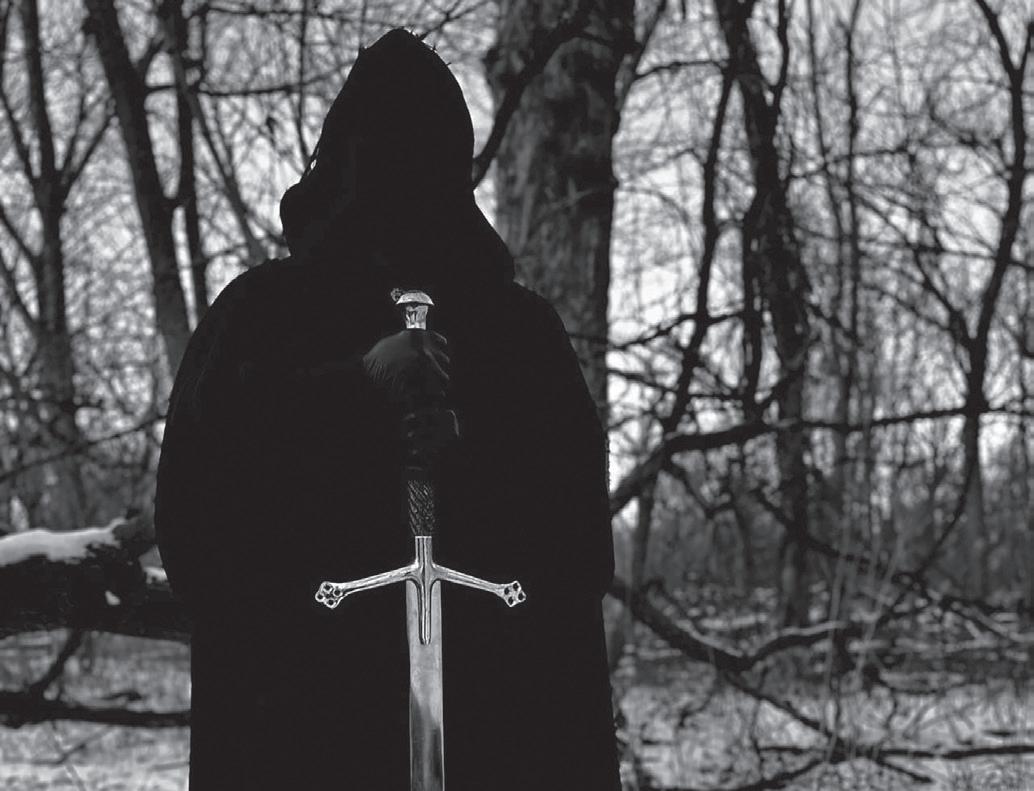

musicians created instrumental interludes that fused elements of dark ambient and electronic music (and usually omitted black-metal hallmarks such as shrieked vocals, tremolo-picked guitars, and blastbeats). Due to Chicago’s strong roots in the genres that inform the style, the city has provided a modest home to parts of what was until recently an extremely loose constellation of artists.
In its early years, dungeon synth was mostly confined to tape-trading circles and online forums, but in the late 2010s it began to grow in popularity as technology made it cheaper to make electronic music at home and social media afforded more opportunities for sharing and appreciating obscure sounds. Since lockdown, people’s appetite for romantic, adventuresome music has skyrocketed—to the degree that dungeon synth, with its strong links to the sword-and-sorcery fantasy milieu, could grow beyond the Internet. The genre now has so many artists experimenting with its conventions (and so many enthusiastic fans) that it can sustain offline scenes.
After that first show at Cole’s, Great Lakes Dungeon Synth set to work on a fest showcasing the area’s practitioners alongside artists from outside the midwest. The Great Lakes Dungeon Siege debuted last year in Fort Wayne, Indiana, and held its second edition last month in Detroit. Now the collective is returning to its old stomping grounds with a free night of music.
Hailing from the foothills of Rochester, New York, Hermit Knight headlines with contemplative, keyboard- driven music enhanced by lo-fi whispers and hisses and field recordings of the natural world. Three locals from the collective complete the bill: Mors Vitaque, a duo whose quiet, ethereal songs meditate on cycles of death and rebirth; Eldritch Wizardry, whose brooding, fantasy-
inspired music could soundtrack a dark quest; and Mortlach, whose simmering, gauzy tracks would befit a vampire rising from the crypt a er a hundred years’ slumber. Dungeon synth’s slow gestation as an underground phenomenon has given birth to a small but recognizable subculture—don’t miss this chance to savor it as it grows. —MICCO CAPORALE
Moio Opening act to be announced. 8 PM, Schubas, 3159 N. Southport, $27. 18+
Nigerian-Irish singer and producer Moio has been releasing his soulful alternative R&B for just a few years, but he’s already making waves. After getting his start as a producer for Dublin’s Chamomile Records collective (and other Irish artists), he began making solo bedroom recordings during COVID
lockdown. His third official single, 2023’s “Moments” (which deals with mismatched expectations in situationships), went viral last December a er he posted a video of a bare-bones acoustic performance on TikTok, and the song hit number one on Spotify’s Viral 50 playlist in seven countries, including the UK, Ireland, and the States. The international hype helped build momentum for his recent debut EP, Earthday , whose six compact songs showcase his vocal and stylistic fluidity. The delicate, reflective “Survival” pairs minimal guitar and icy layers of keyboard with Moio’s forlorn singing, which barely rises above a whisper. On the next track, though, he sheds this sadboi exterior. “Play Hard!” punctuates his silky, strutting vocals with choppy blurts of guitar fuzz and drives them with a hearty disco beat— and for the song’s final 40 seconds, its smooth vibe opens up into a hyperactive dance odyssey crisscrossed with futuristic arpeggiated synths fit for a campy sci-fi action flick. On “Moments,” Moio presents himself as aloof in matters of the heart, but the

steamy, bass-heavy “Lady (I’ll Be Waiting)” proves he’s no stranger to longing. —JAMIE LUDWIG
Tortoise with the Chicago Philharmonic See Pick of the Week on page 23. 7:30 PM, Auditorium Theatre, 50 E. Ida B. Wells, $71–$224. b
The Saints ’73–’78 Chimers open. 8 PM, Metro, 3730 N. Clark, $47.94 in advance. 18+
Punk is more than 50 years old, and by now everyone knows it was born out of the social, political, and economic upheavals of the early 1970s. But the lessons we can learn from genre’s pioneers are timeless—and those pioneers include Australian punk rockers the Saints.
Formed in Brisbane, Queensland, in 1973 by three schoolmates—singer and songwriter Chris Bailey, guitarist Ed Kuepper, and drummer Ivor Hay— the Saints famously became the first band outside the U.S. to put out a punk record when they selfreleased “(I’m) Stranded” in 1976. Their brash, irresistibly catchy distillations of suburban alienation reflected the bandmates’ working-class roots and outsider mentality. The Saints also rejected the hard-line conservatism of Queensland premier Joh Bjelke-Petersen, whose nearly two- decade rule over the state was characterized by systemic racism, violent suppression of dissent, and draconian crackdowns on civil liberties and youth culture. In the 2015 Saints documentary Stranded , musicians describe being thrown in jail for the crime of standing outside a gig. “It’s like the frog in the boiling water—you never really kind of notice as the temperature rises,” Hay told the Guardian last year. “But whenever you went out, there was always the feeling that the police will come and grab you. If you were under 20, you were a target.” BjelkePetersen resigned in 1987, a er the Fitzgerald Inqui-

Find more music listings at chicagoreader.com/musicreviews
ry exposed widespread corruption and abuse of power in his administration.
In February 1977, the Saints released their debut album, also called (I’m) Stranded. That May, they relocated to London, where their DIY spirit prevailed against music-industry norms and the increasing conformity of the punk scene. They butted heads with their label at the time, EMI, because they refused to change their look (the label wanted them to dress more marketably and visibly “punk”) and because they continued to experiment with new sounds and styles. The Saints’ brilliant second record, 1978’s Eternally Yours, borrowed from Stax soul and R&B artists such as Sam & Dave and added a horn section; its lyrics took aim at consumerism (“Know Your Product”), the commodification of artists (“No, Your Product”), and the repressive government back home (“Orstralia”). Frustrated by artistic clashes with Bailey, Kuepper quit the Saints following their adventurous third record, 1978’s Prehistoric Sounds . Hay left in the late 80s, and Bailey led the group through many more incarnations (among them a few brief 2000s reunions that included all three cofounders) until his death in 2022.
Last year, In the Red released a four-LP box-set version of (I’m) Stranded, credited to the Saints (’73–’78), which commemorates the artistry and spirit of the Saints’ original lineup. To mark the occasion, Kuepper and Hay are taking the music on the road with an all-star lineup: multi-instrumentalist Mick Harvey (the Bad Seeds, the Birthday Party), bassist
Peter Oxley (Sunnyboys), and vocalist Mark Arm (Mudhoney). Later this month, Fire Records will release Long March Through the Jazz Age , the final studio album Bailey made with the Saints. Recorded in 2018, the record’s rich, introspective songs testify to Bailey’s undimmed talent and make a fitting bookend to the band’s early material. It’s been a long time since the early 70s, but those who fight the good fight live on forever.
—JAMIE LUDWIG
WEDNESDAY12
Anycia 7 PM, House of Blues, 329 N. Dearborn, $24.90–$71. b

Anycia’s raspy drawl is slow and unconcerned, working as the centripetal force of every song she’s on. The Atlanta rapper always sounds unfazed by whatever production is going on around her and whatever her guests get up to—and the effect is hypnotic. Her 2024 debut album, Princess Pop That, includes the bold hit single “Back Outside” (featuring fellow Georgia rapper Latto), and while it aims for sports-anthem grandiosity, the nonchalant charis-


(“Type Beat”), braggadocio (“Splash Brothers”), or cocksure flirtation (“So Fine,” featuring Chicago R&B singer and rapper Tink). “So Fine” appears on Anycia’s July mixtape, Grady Baby, which she released with DJ Drama as part of the Atlantabased DJ’s Gangsta Grillz series. The record, which pays homage to her hometown, contains samples from ATL stars such as Jeezy, Lil Jon, and Waka Flocka Flame, but Anycia stands out from the pack. It’s especially obvious on “Never Need” (which samples Khia’s 2001 single “Don’t Trust No Nigga”), where her minimalist flow takes center stage between the wordier but similarly sleepy Karrahbooo and the ferocious spitfire GloRilla.

ma in Anycia’s subdued delivery becomes the only thing that matters.
At its best, Anycia’s voice finds ways to subtly ensnare you—you can trace the contours of a phrase and sense how every word resonates. Frequently she’ll draw out the last syllable of a line so that its lingering presence acts as a conduit for disdain
The highlights of Anycia’s discography come in little bursts. There’s a quiet, already-over-it revulsion on “IDK Freestyle” when she talks about men’s false promises, and she suffuses the hushed lines of “Dive In” with ecstatic sensuality. And when she deploys her calling card—punctuating lines with “hyuh”—that syllable serves as a simple, elegant prism of emotion that enhances the mood of any track. When Anycia raps, she makes sure every word counts. —JOSHUA MINSOO KIM v



1/9/26
FRIDAY, NOVEMBER 7 8PM Jack Blocker In Szold Hall
SATURDAY, NOVEMBER 8 8 PM Kurt Vile & Terry Allen In Maurer Hall
LOCAL NONPROFIT Asian Improv Arts
Midwest (AIRMW) presents this year’s Chicago Asian American Jazz Festival beginning Friday, November 7. Celebrated bassist, shamisen player, filmmaker, and educator Tatsu Aoki founded AIRMW in 1984, and his organization launched the festival in 1995 (though both initially went under other names).
A furry ear to the ground of the local music scene
lineup includes Tatsu, Kioto, reedists Mwata Bowden and Edward Wilkerson Jr. , cellist Jamie Kempkers, percussionist Coco Elysses, and members of the Tsukasa troupe of taiko drummers. All shows begin at 8:30 PM; tickets are $20, $10 with student ID.

THURSDAY, NOVEMBER 13 7:30 PM Robert Plant's Saving Grace feat. Suzi Dian In Maurer Hall
SATURDAY, NOVEMBER 15 8PM Ari Hest In Szold Hall
SATURDAY, DECEMBER 6 10:30AM Let It Snow Show!
In Szold Hall
SATURDAY, DECEMBER 6 5PM & 8PM Irish Christmas in America In Maurer Hall
SUNDAY, DECEMBER 7 7PM
THURSDAY, DECEMBER 11 7:30PM
FRIDAY, DECEMBER 12 7:30 PM
SATURDAY, DECEMBER 13 3 PM & 7:30PM
SUNDAY, DECEMBER 14 4PM
An Acoustic Christmas with Over the Rhine In Maurer Hall 27th Annual Holiday Caroling Party with Mary Schmich & Eric Zorn In Maurer Hall
THURSDAY, DECEMBER 11 8PM with special guest Jeff Kazee
FRIDAY, DECEMBER 12 8PM The Aimee Mann & Ted Leo Christmas Show with Very Special Guests: Paul F. Tompkins, Nellie McKay & Josh Gondelman
The Mayfair Theatre at the Irish American Heritage Center • 4626 N Knox Ave
“AIRMW is committed to advancing the understanding and profile of Asian American cultures through the traditional and contemporary cultural arts,” Aoki says in a statement on the occasion of the fest’s 30th anniversary. “We are proud of our history of producing high quality arts programs reflecting the multicultural, multi-ethnic reality of Chicago and the nation. For three decades, this annual festival, and especially this year’s program, are perfect examples of that mission in action.”
Elastic Arts will host the entire four-day event, with the exception of a panel discussion at AIRMW’s headquarters (4875 N. Elston) at 1 PM on Saturday, November 8. San Francisco saxophonist Francis Wong opens Friday night by reconvening his Chicago Time Code trio, which features Aoki and pianist Bradley Parker-Sparrow; they haven’t played together since releasing an album in 1995 via the first Asian Improv Arts, cofounded by Wong in the Bay Area. Chicago saxophonist Jeff Chan headlines with Ratchet, his quartet with bassist Ausberto Acevedo , keyboardist Michael Perkins , and guitarist Chad Clark
LAST WEEK, A NEW Chicago band called Leroy the Poet dropped their debut single, the lo-fi slacker number “Punching From the Other Side.” Leroy the Poet are something of a youth-scene supergroup. Their four-piece lineup consists of vocalist-guitarist Lottie Malkmus (daughter of Pavement front man Stephen), who lent her DJ name to the band; Neptune’s Core guitarist-vocalist Jackie Cywinski ; and two members of Uniflora, drummer Ruby O’Brien and bassist Theo Williams. For more on Chicago’s young indierock scene, be sure to read the big story on page 18!
flutist Constance Volk , among others. Conn will perform two sets at Sleeping Village, each focused on one side of Bobby’s Place In Masks open; tickets are $19.57 in advance, and the music starts at 9 PM.

From
Saturday night features two Chicago-based pianists and singers: Ester Hana playing solo, followed by Yoko Noge with her band Jazz Me Blues . Sunday’s bill is three acts deep: local multidisciplinary artist Takashi Shallow; Ann Arbor pianist and electronic artist ChienAn Yuan, debuting the new group All Things Shining with saxophonist Marcus Elliot , MC and poet Chace Morris , and producer Jon Monteverde ; and Chicago saxophonist Mai Sugimoto in a trio with local sound artist (and former J-pop singer) Haruhi Kobayashi and Aoki’s daughter Kioto , who plays shamisen and traditional percussion. The trio has an album called Miminari due out this month on Asian Improv Records. On Monday night, Tatsu Aoki’s long-running Miyumi Project closes the festival with two sets; its current
ON THURSDAY, NOVEMBER 6 , veteran Chicago underground rocker Bobby Conn headlines Sleeping Village in celebration of his latest album, Bobby’s Place , which came out on German label Tapete in August. The first side of the LP puts Conn’s eccentric glam rock through a sitcom filter—the title track sounds like the theme song to a 1970s TV show (though with more strings thanks to Conn’s wife, violinist Monica Boubou). The second side, confusingly labeled “Side A,” is a synth-heavy and largely instrumental fusion of ambience, psychedelia, and hypnotic Krautrock beats, with contributions from Mucca Pazza bassoonist Airan Wright , percussionist Michael Zerang, and Ensemble dal Niente
FIVE YEARS AGO , Stones Throw issued the first solo full-length by veteran Chicago producer the Twilite Tone , The Clearing The album includes “I Still Need Love,” which drives its floating, glassy synths and occasional sweet soul vocal sample with hard, sparse drum loops. Recently Tone posted online that he’s been wanting to add original vocals to the track. On Thursday, November 6, he’ll drop “I Still Need Love 2,” with new performances by soul vocalist Madison McFerrin and rapper Common , who became one of Tone’s first collaborators in the late 80s. Tone’s label, All of the Above, will release the song in collaboration with Chicago hip-hop label Closed Sessions. IN THE OCTOBER installment of the Reader ’s City of Win series, Joshua Eferighe wrote about Chicago rapper Thirteendegrees°, one of the leaders of the underground hip-hop movement calling itself #NewChicago . The movement’s emerging MCs have unconventional styles that have attracted a growing young audience, and one of the most promising, Your Stepdad , dropped the new project BlackAlt last week. Your Stepdad’s blunt verses and snappy, bitten-off delivery lend a taut energy to the album’s brooding bass lines, forlorn vocal samples, blurry synths, and asymmetrical drum loops—and he pairs this combo with guitars reminiscent of midwest emo. His voice barrels through “Crash” (featuring Vic Mensa ) like a bobsled course, even though it sounds like a sped-up American Football B-side. He’s not the first rapper to mine 90s emo, but few in that lane take his battle-ready approach to the mike. —LEOR GALIL
Got a tip? Email your Chicago music news to gossipwolf@chicagoreader.com.
LOVE
By DAN SAVAGE
Q : I’m a 40-year-old single woman ready to be a mother. I don’t want to pay for jizz and the two friends I asked live abroad and don’t want to make a kid they can’t be present for. So, I posted on Feeld and now I’m drowning in free jizz! Men are literally lining up. Meeting a male life partner has been hard. Existentially and practically, what do you think about all this? The clock is ticking!
a : “It’s painful to pay for sperm after a life of fending it off,” said Diana Adams, Esq., executive director of the Chosen Family Law Center. “But going with sperm off apps runs the risk in these conservative times of the donor being declared a dad who has parental rights. Only choose someone responsible and reliable enough to sign a Known Donor Agreement drafted by a lawyer in your state—that’s only a few thousand dollars well-spent to protect you and your child.”
Q : If a guy refers to his wife as his “wife” in quotation marks . . . what does that mean?
a : It could mean she’s his wife in name only . . . or it could mean he wants you to believe she’s his wife in name only . . . but it doesn’t mean his marriage is open or that this woman’s “husband” can be trusted.
Q : I’m a 35-year-old cis het woman with vaginismus. I’ve only had one PIV partner. We made it work, but it was challenging and years
ago. Since then, I’ve only been with one person, and he couldn’t have PIV for religious reasons, so it wasn’t an issue. I’ve met someone new and will need to broach the subject. Do you have any advice on how and when to talk about it? And any advice for treatment would also be great. I have dilators. I don’t have resources for a sex therapist.
a : “Dilators are a great start,” said Dr. Rachel Gelman, a pelvic floor physical therapist and the founder of Pelvic Wellness. “But I strongly recommend consulting with a pelvic floor therapist. They can make sure you are using the dilators correctly, as well as teach you other exercises and use various treatment techniques to address any tension of the pelvic floor and surrounding muscles that contribute to vaginismus. They may also help with strategies to approach the conversation with this new partner, which ideally you want to have before you enter the bedroom. Certain conversations tend to be easier when you are both fully dressed.”
Q : We enjoy sex in public places—we’ve done it in a hospital, a club, offices, hotel pool, highway overpass—but don’t want to get caught by security cameras.
a : No one looks at security camera footage unless a crime has been committed and reported—so, if you’re careful not to commit crimes (or any additional crimes)
and don’t have sex where other people are committing crimes, it’s unlikely that anyone will review the security camera footage you’ve almost certainly been caught on already.
Q : Any secrets for dry mouth when it’s time to give sloppy head?
a : Keep some of those Del Monte fruit cups in the fridge—the kind with the alarmingly red cherries in them—and have a quick sip of the syrup before you begin.
Q : Someone asks you if you have HPV right before sex. What are you supposed to say? I went with: “Probably?”
a : No notes!
Q : I love using toys and always have. The last five years or so I have been trying my best to be as ecominded as possible. Is there a way to properly dispose of old toys when they reach their expiration date? I have a handful of old toys and am not entirely sure how to safely dispose of them to keep them out of landfills.
a : Million-dollar idea: Open a chain of sex toy cemeteries where eco-minded people who don’t wanna see their beloved old sex toys wind up in landfills can come and bury them instead. v
Ask your burning questions, download podcasts, read full column archives, and more at the URL savage.love. m mailbox@savage.love

Assistant Professor of Biology Roosevelt University Chicago, Illinois
Salary Range: $46,000.00$61,000.00 per year Teach undergraduate and graduate courses in microbiology (general bacteriology and advanced courses) and related disciplines. Provide student academic and career advising, maintain an active research program, and perform departmental service. Must have a doctoral degree in microbiology, biology, or a related field. Qualified candidates should send their resumes to hrquestions@ roosevelt.edu and reference job code APB8325
Avant LLC seeks in Chicago, IL (1) Credit Risk Mngr (#39108). $138,632158,632/yr. (2) Assoc Prdct Mngr (#61015) to sprt data modeling. $100,000-115,000/yr. Telecom prmtd bth rls. Apply at jobpostingtoday. com w/ ref#.
Conexus Food Solutions (Chicago, IL) seeks ERP Database Administrator for the design/implementation & on-going support Conexus’ ERP system & work w/business to facilitate the configuration/ adoption/& ongoing sustainability of the ERP platform. Remote work option 10% of the time. Salary: $110,178/yr. Apply at conexusfood.com/ careers, Job ID: ERP Database Administrator
Director-Data Science Products sought by Sigmoid Analytics, Chicago, IL to develop & evolve MTA product, etc. 25% US and/or Int’l travel. Salary $150K - $210K/ yr. Deg’d applicants exp’d w/ use of Python for regression based attributn models for Media Mix, etc. Send resume to piyush@sigmoidanalytics. com & refer to “D-DSP”
Market Research Analyst, F/T, Master’s Degree in Marketing, Business Administration, or Related. Mail resume: El Tarasco Rivera Inc, 4358 W 51st St, Chicago, IL 60632
Slalom has multiple openings for the following positions at its Chicago,
IL office (various types/ levels): Standard Company Benefits — Technology Consultant, Principal Data Engineer [Job code 88089]. Design strategies for enterprise databases, data warehouse systems, and multidimensional networks. Must be available to work on projects at various, unanticipated sites throughout the US. Telecommuting is permitted. $177,307$192,038 per year. —IT Project Management Consultant [Job code 58935]. Plan, initiate, and manage information technology (IT) projects. Telecommuting is permitted. Must be available to work projects at various, unanticipated sites throughout the United States. $160,737$176,811 per year.
TO APPLY: Go to www. jobpostingtoday.com, search for job code & submit resume.
Ulta Beauty Credit Services Corporation has 2 positions available in Bolingbrook, IL. Below positions can work remotely/ telecommute up to 100%.
—Sr. IT Analyst, Logistics & Warehouse Operations. Functional responsibility for integration into SAP host systems. BS: CS, Engg, or rel. 5 yrs exp supporting warehouse mgmt sys in retail or high vol industry. Other exp req. Pay $153,317 - $154,317/ yr. Job ID 409569. —Sr. IT Manager - Salon Systems. Drive holistic vision & strategy for Salon Systems across the enterprise. BS: CS, or rel. 5 yrs dev exp in sw dev. Other exp req. Pay $186,867 - $187,867/ yr. Job ID 409570. Apply: https://careers. ulta.com/careers/

CHESTNUT ORGANIZING AND CLEANING SERVICES: especially for people who need an organizing service because of depression, elderly, physical or mental challenges or other causes for your home’s clutter, disorganization, dysfunction, etc. We can organize for the downsizing of your current possessions to more
easily move into a smaller home. With your help, we can help to organize your move. We can organize and clean for the deceased in lieu of having the bereaved needing to do the preparation to sell or rent the deceased’s home. We are absolutely not judgmental; we’ve seen and done “worse” than your job assignment. With your help, can we please help you? Chestnut Cleaning Service: 312-332-5575. www.ChestnutCleaning. com www. ChestnutCleaning.com
MASSAGE $80 Full Body Massage $80/Hour NO EXTRAS!! Service will not be provided!! (464) 238-4844

IDM/EDM Artists Needed. Original Music Only. idm-edm.com

Go Store It Chicago Northside StorageLakeview, 2946 N Western Ave, Chicago, IL 60618 hereby gives NOTICE OF PUBLIC SALE of the storage space(s) listed below, containing household and other goods will be sold for cash on Nov 17th,2025 2:00pm with the contents being sold to the highest bidder. Owner reserves the right to bid. The sale is being held to satisfy a landlord’s lien, in accordance with Illinois Compiled Statutes Chapter 770 ILCS 95/, and will be held online at www.storagetreasures. com. C44 Hector Arce Jr; C51 George Hull; H05 Cian Omahony; O02 Karl Sullivan; P26 Cian Omahony; T058 Cipriano Venegas; T165 Yesi Barzaga; Z05 Michael Newton; Z38 Mercedes Christmas Chicago Northside Storage
SINCE 1892
EVERCLEAR
SPARKLE AND FADE
30TH ANNIVERSARY + LOCAL H, SPONGE
LEIF VOLLEBEKK REVELATION TOUR + VALLEY JAMES
CINDY LEE + FREAK HEAT WAVES
THE ACES GOLD STAR BABY TOUR + LYDIA NIGHT
MON ROVÎA + RYMAN
JOSH RITTER & THE ROYAL CITY BAND + TRÉ BURT
BEAR VS. SHARK + SIGNALS MIDWEST, ECK!
BEACH FOSSILS + BEING DEAD
AN EVENING WITH BELLY
PSYCHEDELIC PORN CRUMPETS + GHOST FUNK ORCHESTRA
POST ANIMAL + THE SLAPS
SAMARA JOY
CHROMEO PRESENTS: FANCY FOOTWORK + THE COOL KIDS
KITCHEN DWELLERS + THEM COULEE BOYS / HORSESHOES & HAND GRENADES × DEEP CUT
KYLE KINANE KINANESGIVING
ALGERNON CADWALLADER
+ GLADIE, WALTER ETC. × RIOT FEST
SILVANA ESTRADA VENDRÁN SUAVES LLUVIAS + BEDOUINE
FOXING + POOL KIDS
ALL THEM WITCHES HOUSE OF MIRRORS TOUR + KING BUFFALO
MARIACHI HERENCIA DE MÉXICO
A MARIACHI CHRISTMAS
ATERCIOPELADOS GENES REBELDES TOUR
DESSA + MERMAID
THE ARMED EVERYTHING NEEDS TO BE DESTROYED + PROSTITUTE
+ ACCESSORY
SIXPENCE NONE THE RICHER O'NIGHT DIVINE: A SIXPENCE CHRISTMAS THE LEMONHEADS LOVE
+ ERIN RAE
JD MCPHERSON SOCKS: A ROCK N’ ROLL CHRISTMAS TOUR + MELISSA CARPER
HOLLYY 5TH ANNUAL HOLLYY-DAYS + RUDY DE ANDA, SAMUEL AARON
THE DISCO BISCUITS FALL TOUR 2025 × DEEP CUT
DEHD'S BYE BYE ‘25 NYE RUN + WOMBO / SHARP PINS × 93XRT
DEFFJAM CELEBRATING THE LIFE OF RYAN DEFFET
JONAH KAGEN CATE LE BON
DRY CLEANING + YHWH NAILGUN